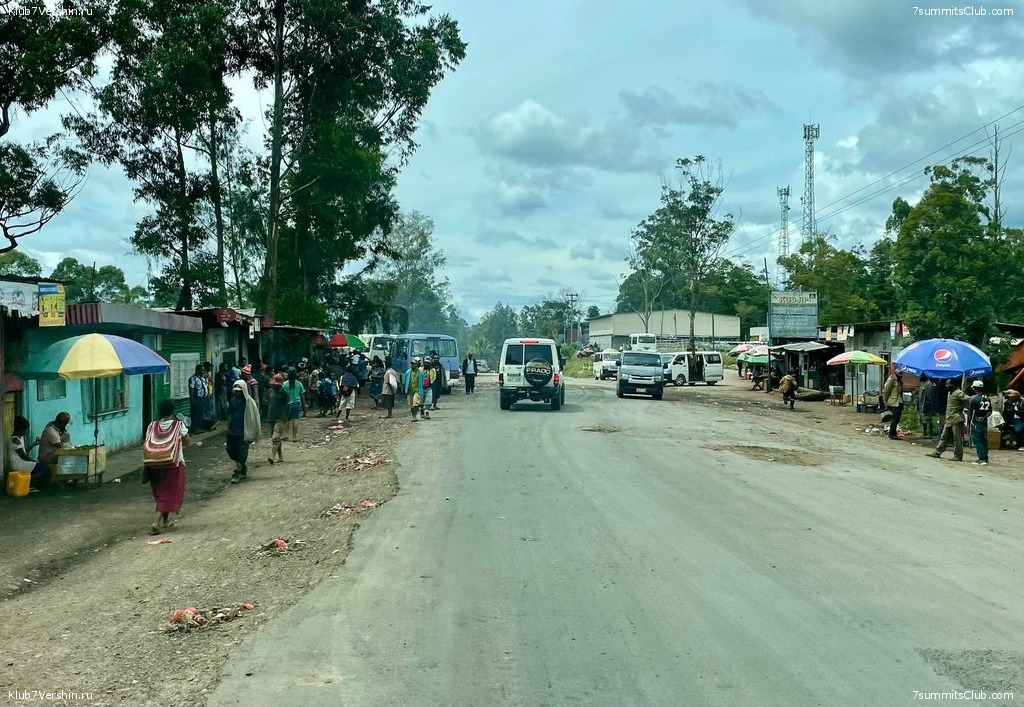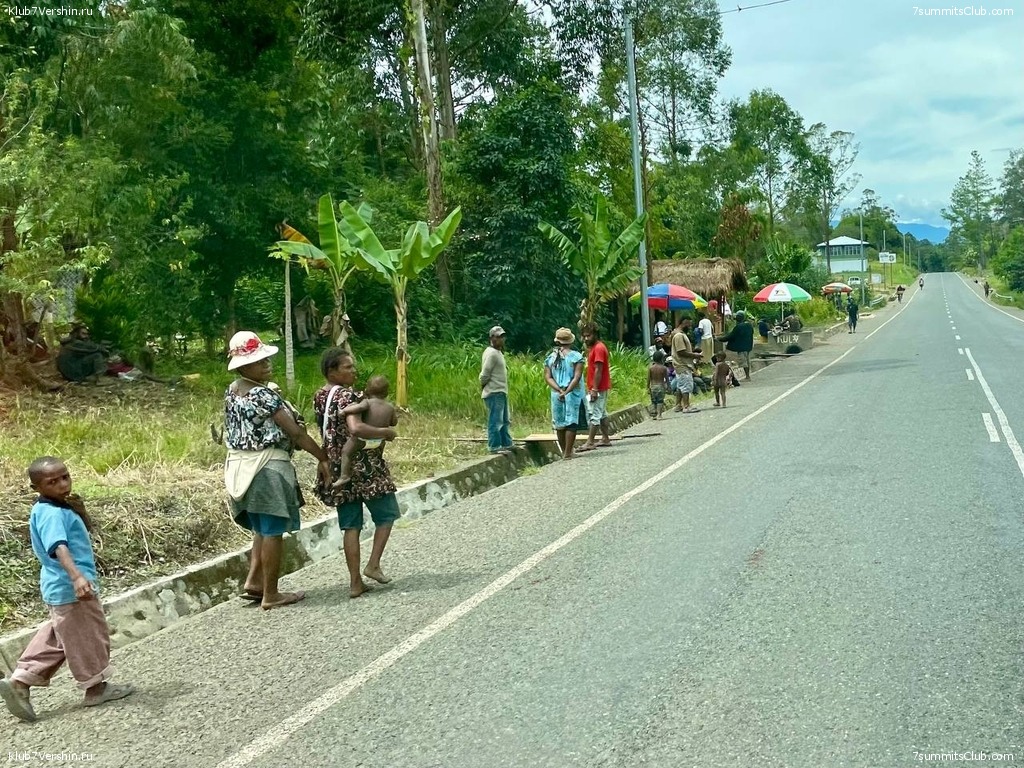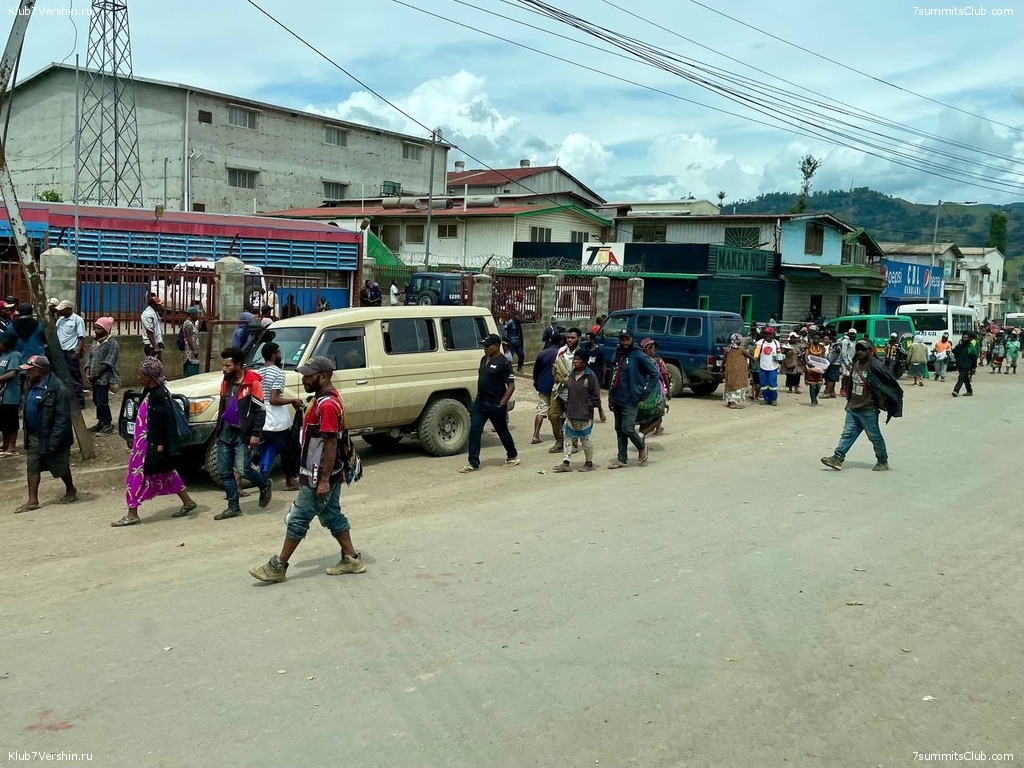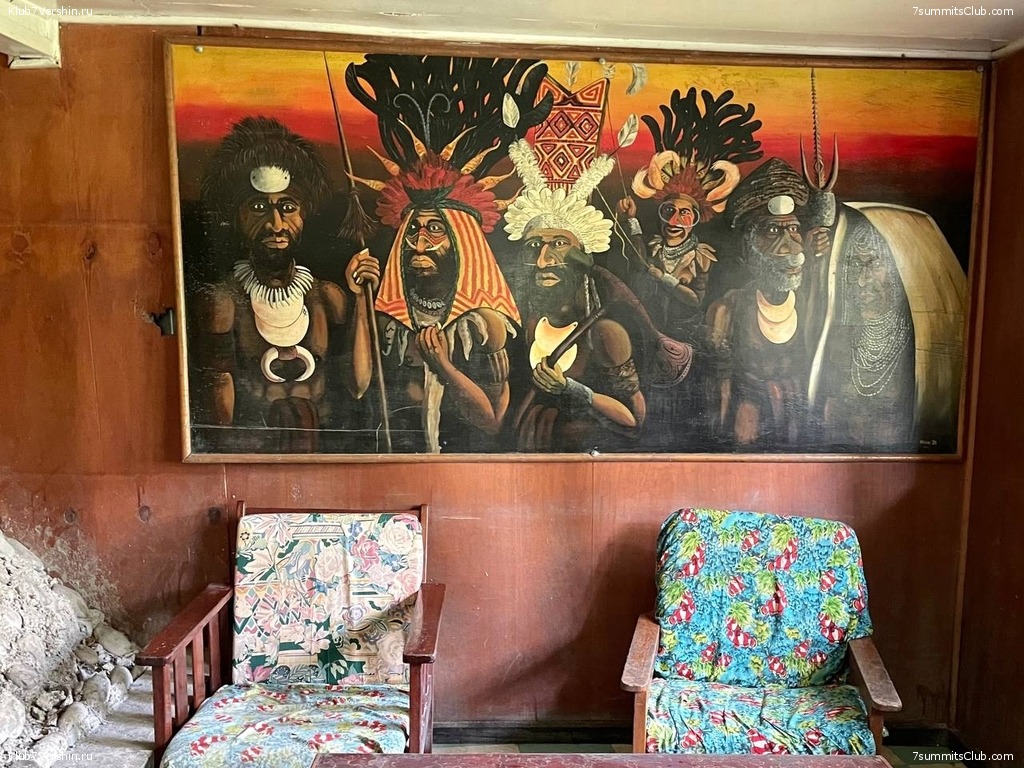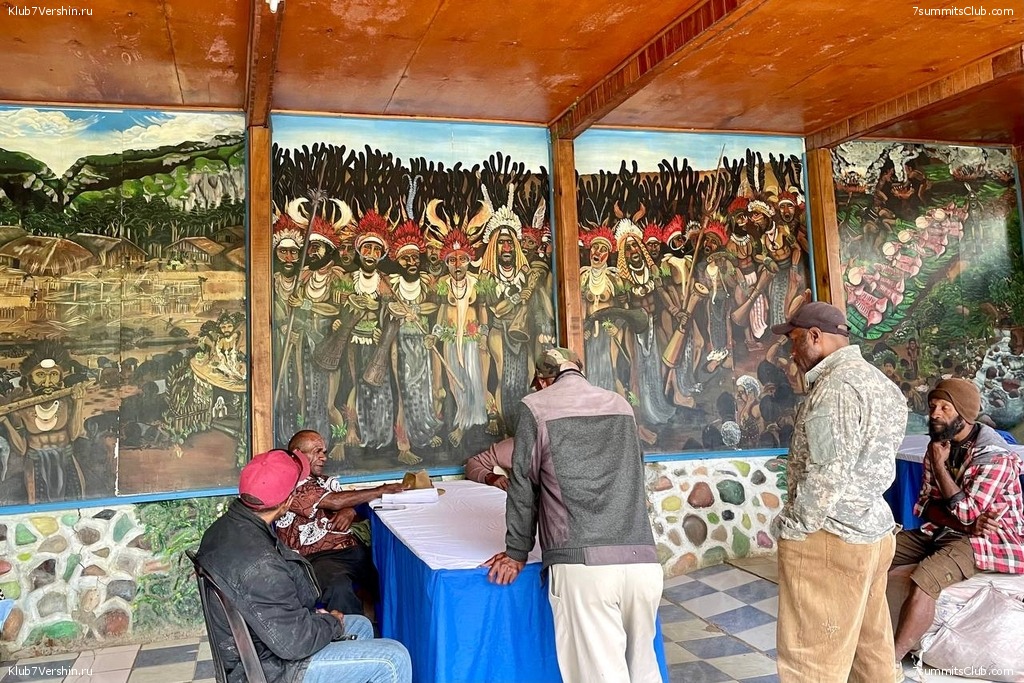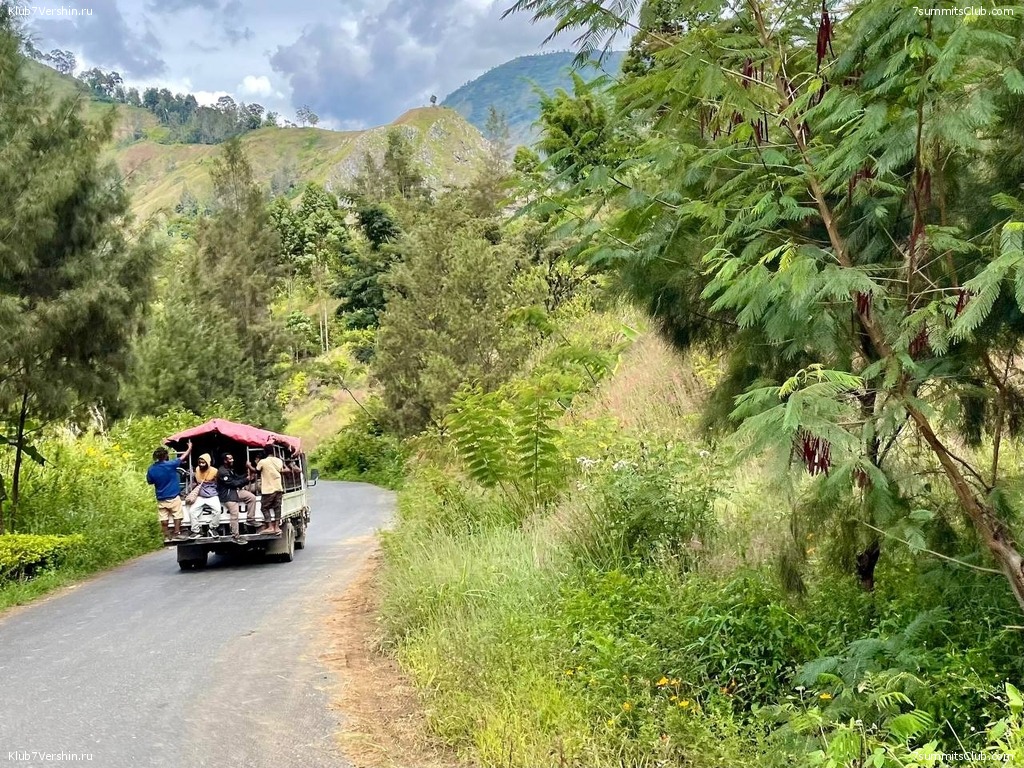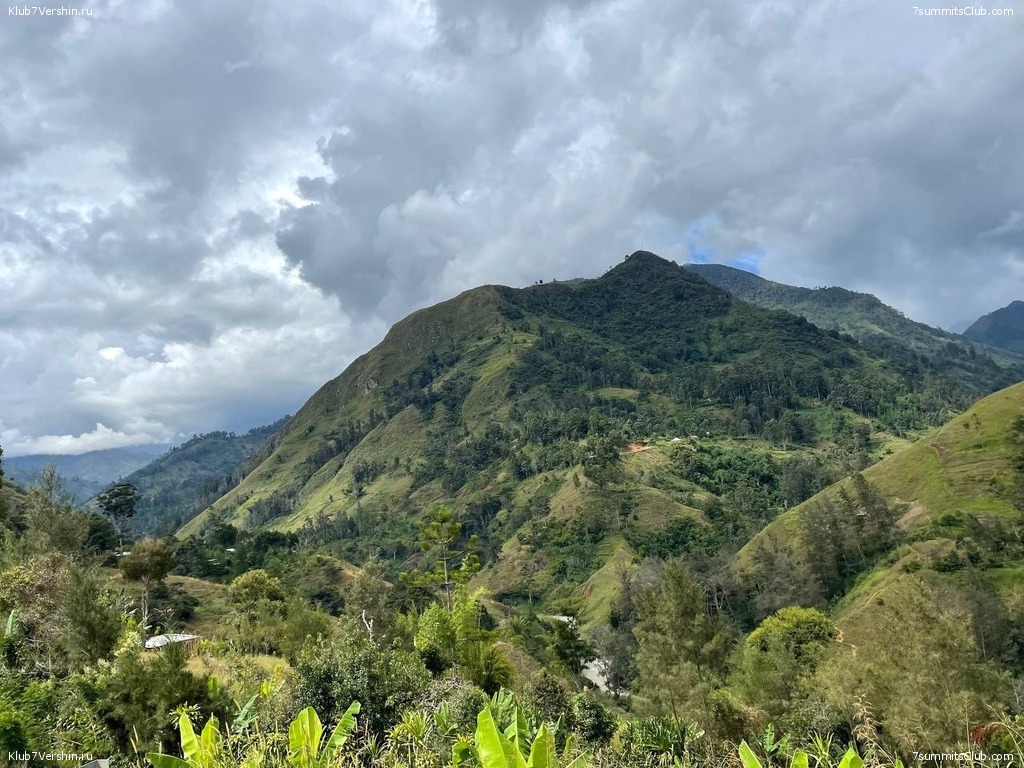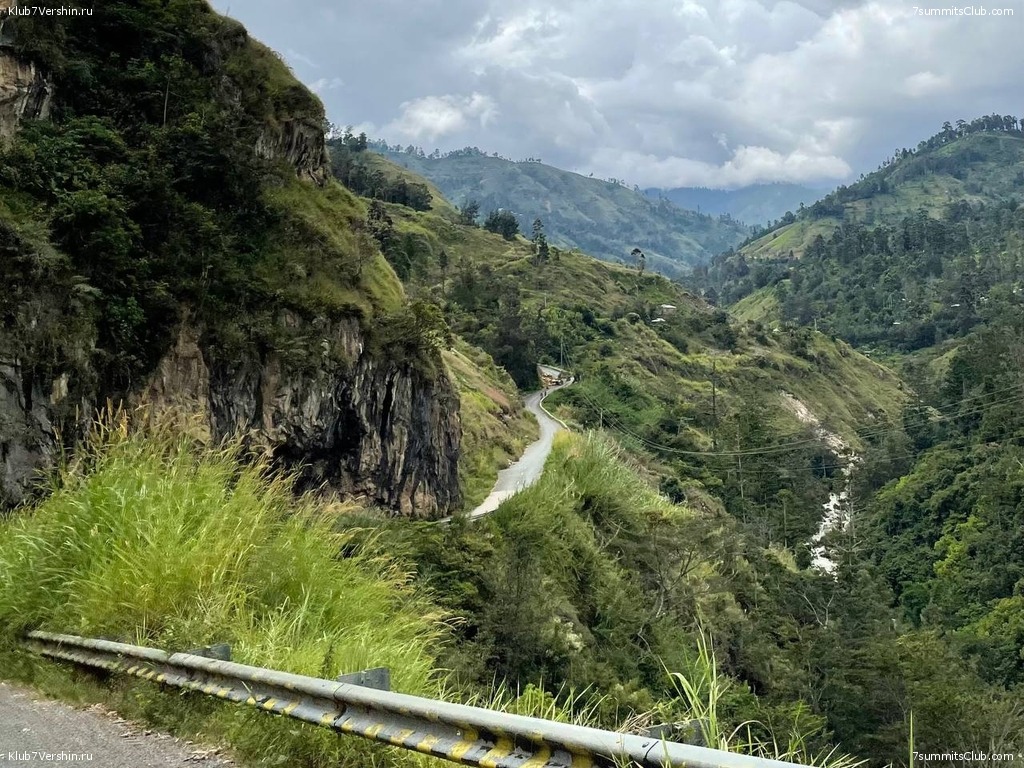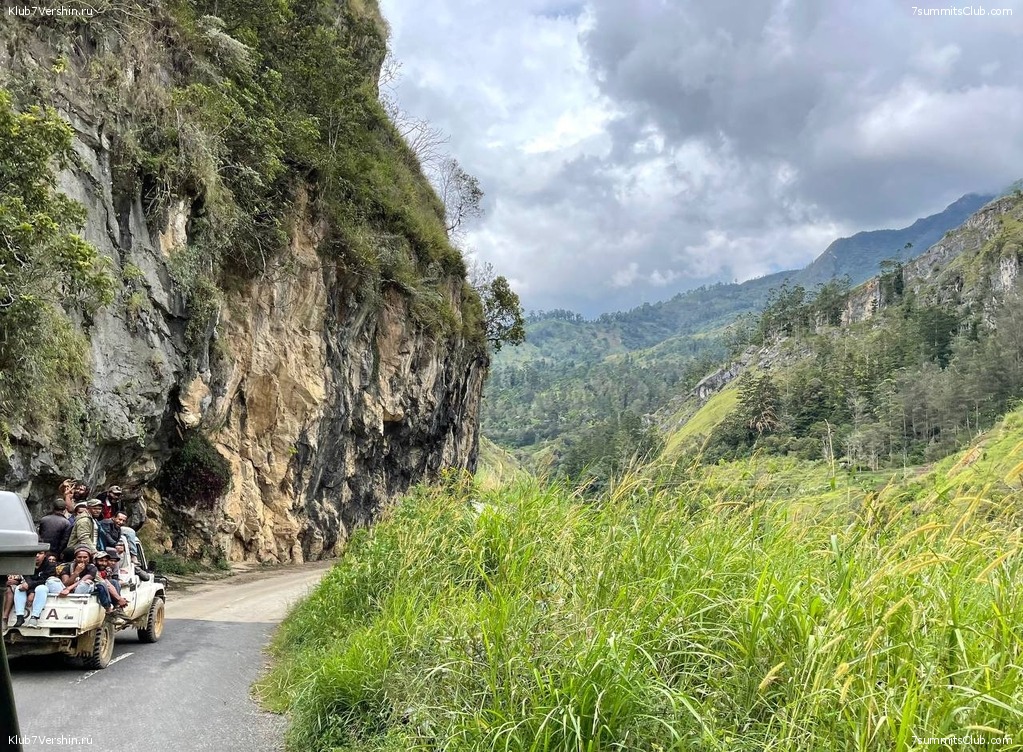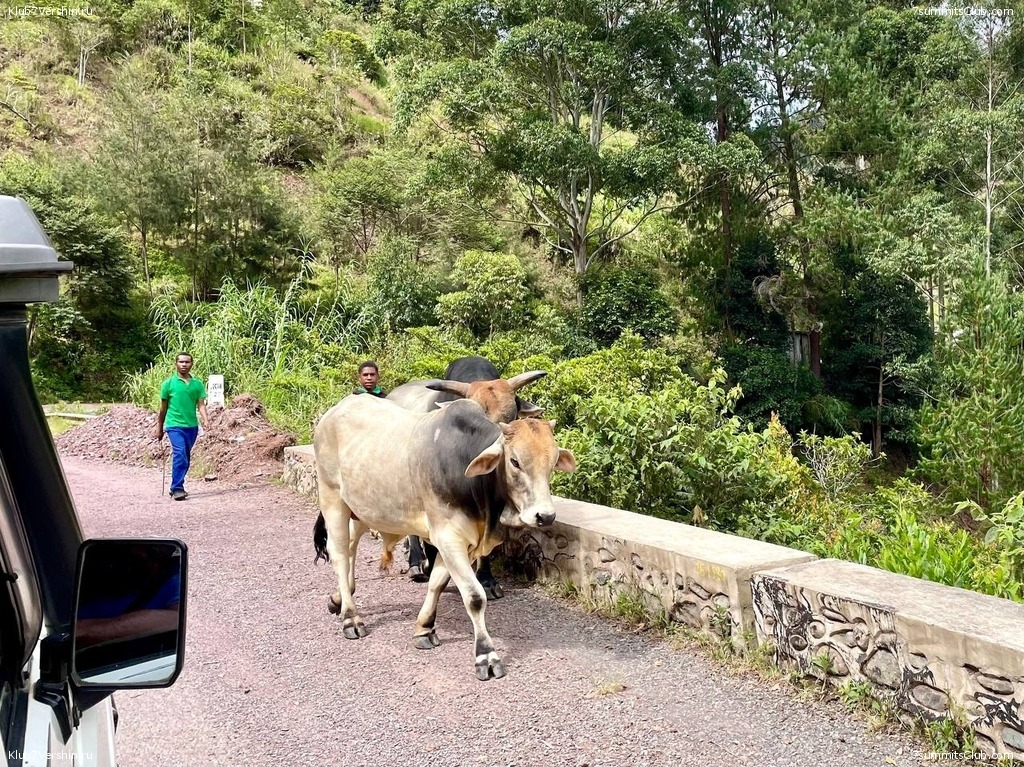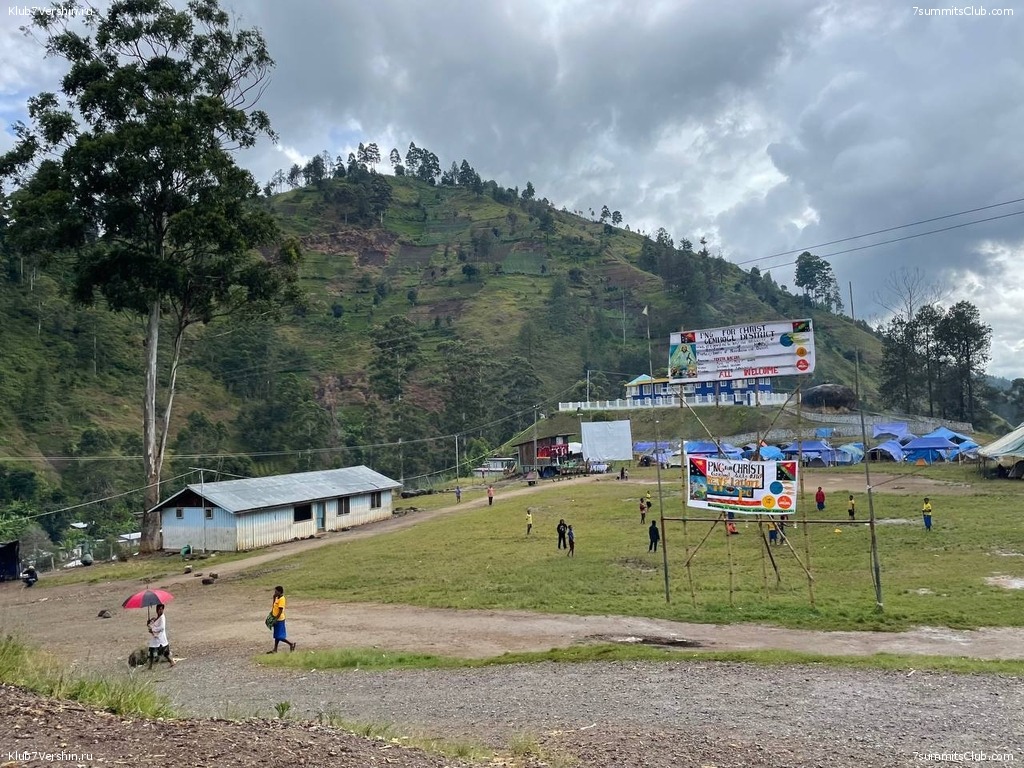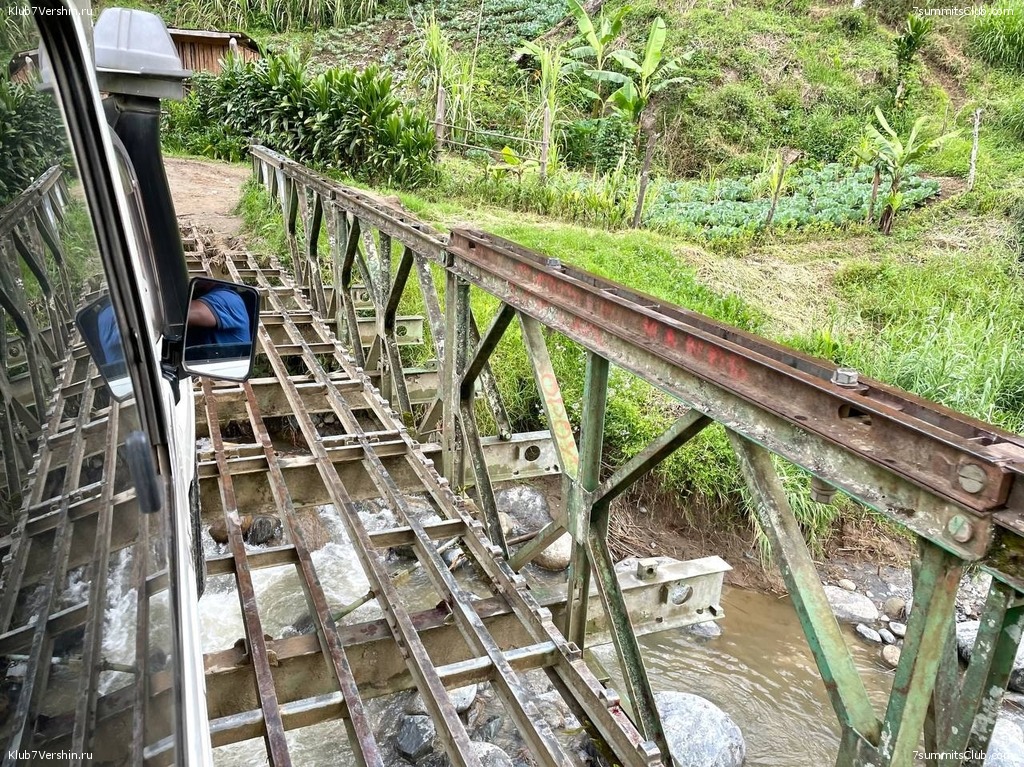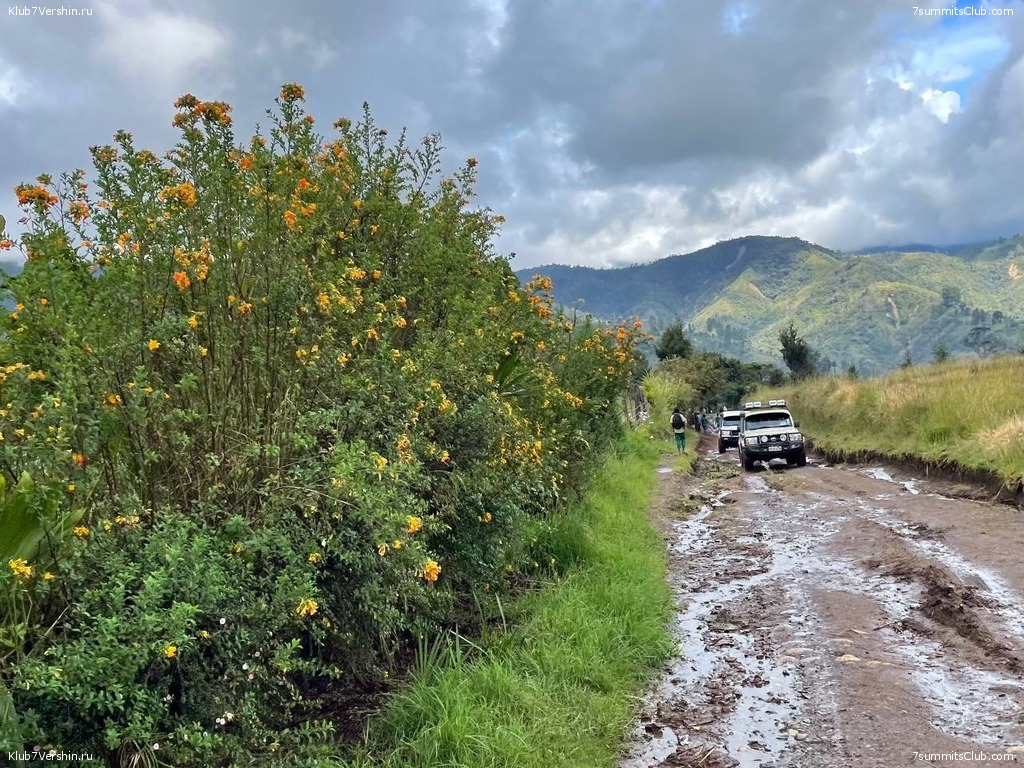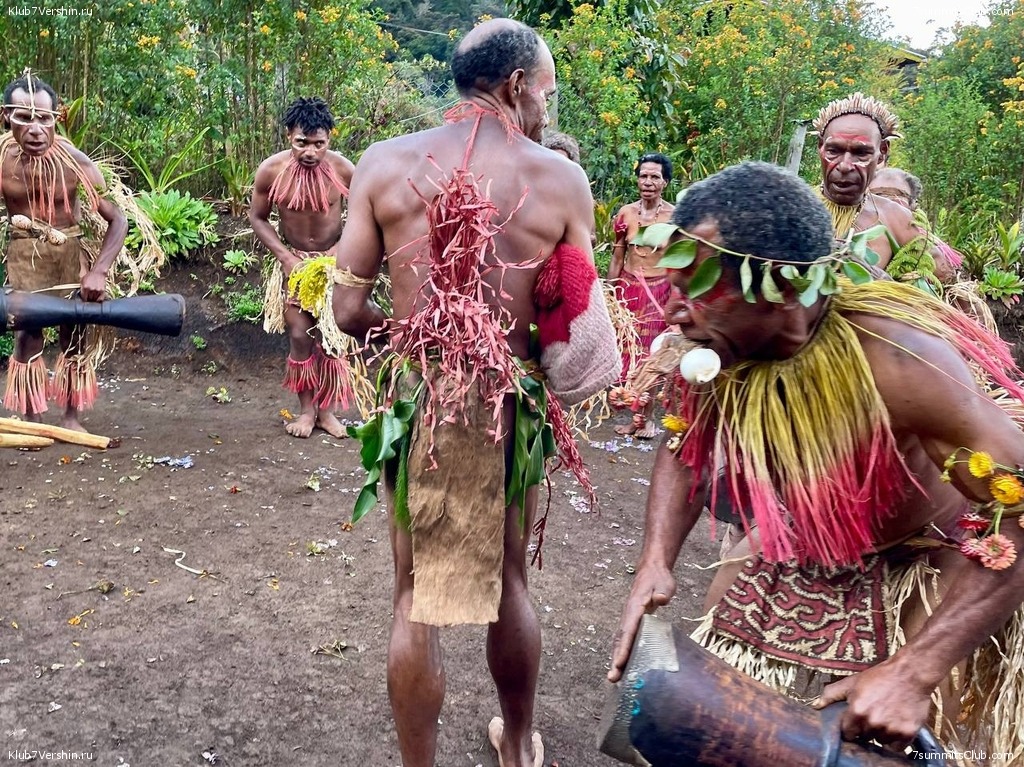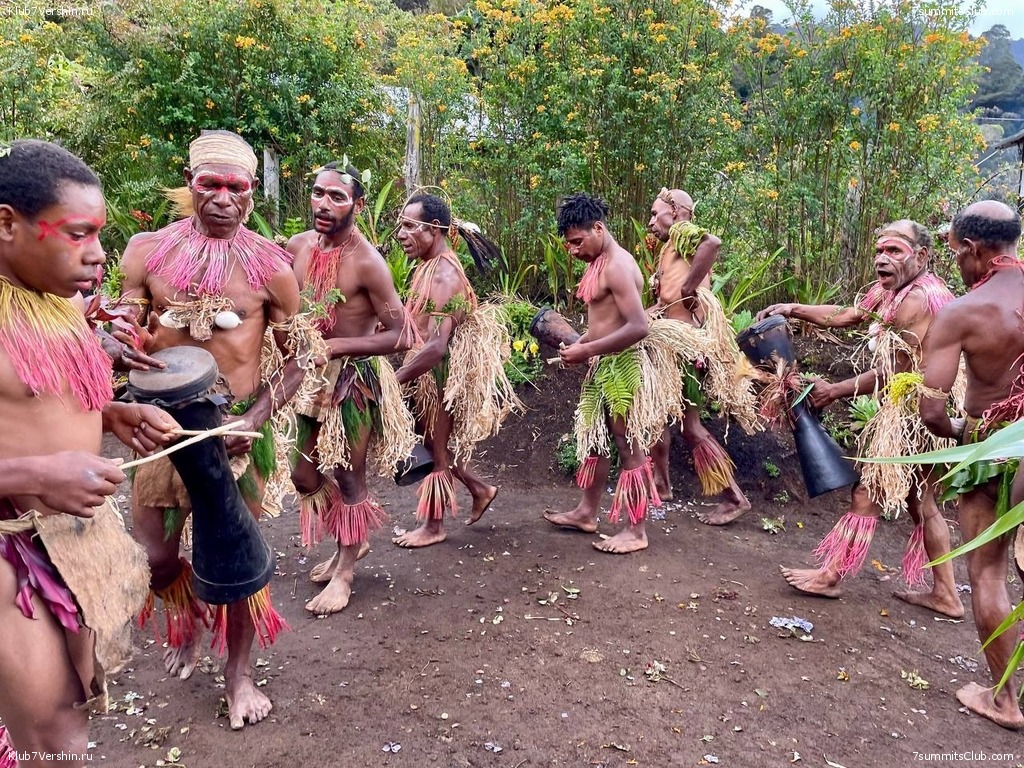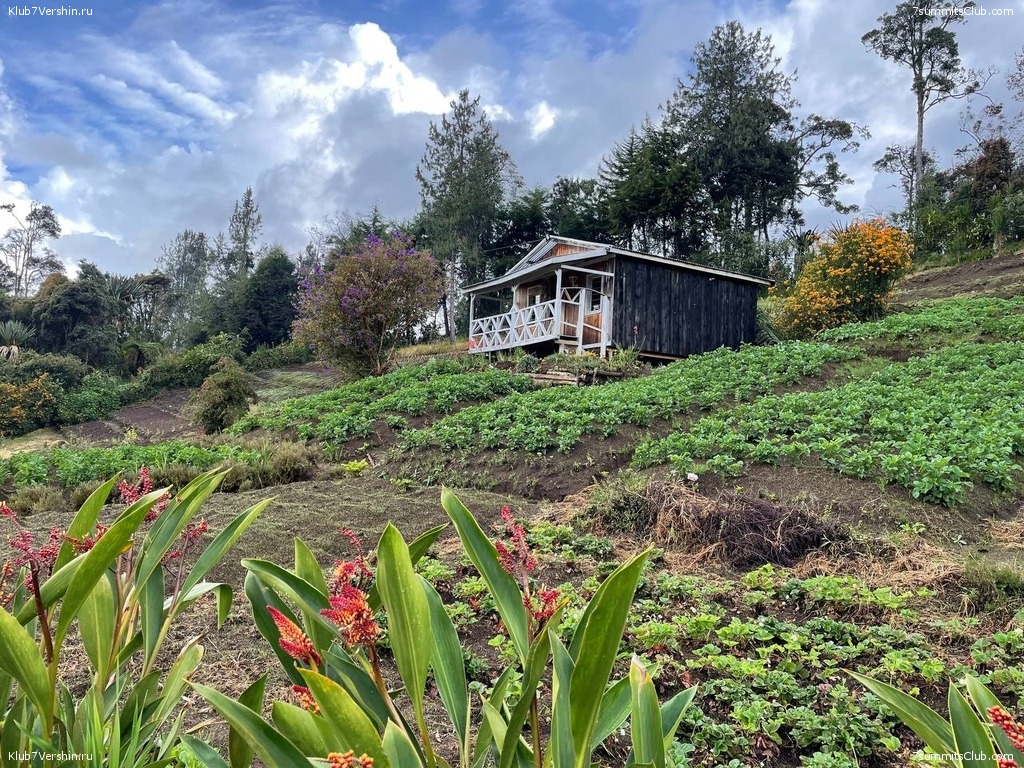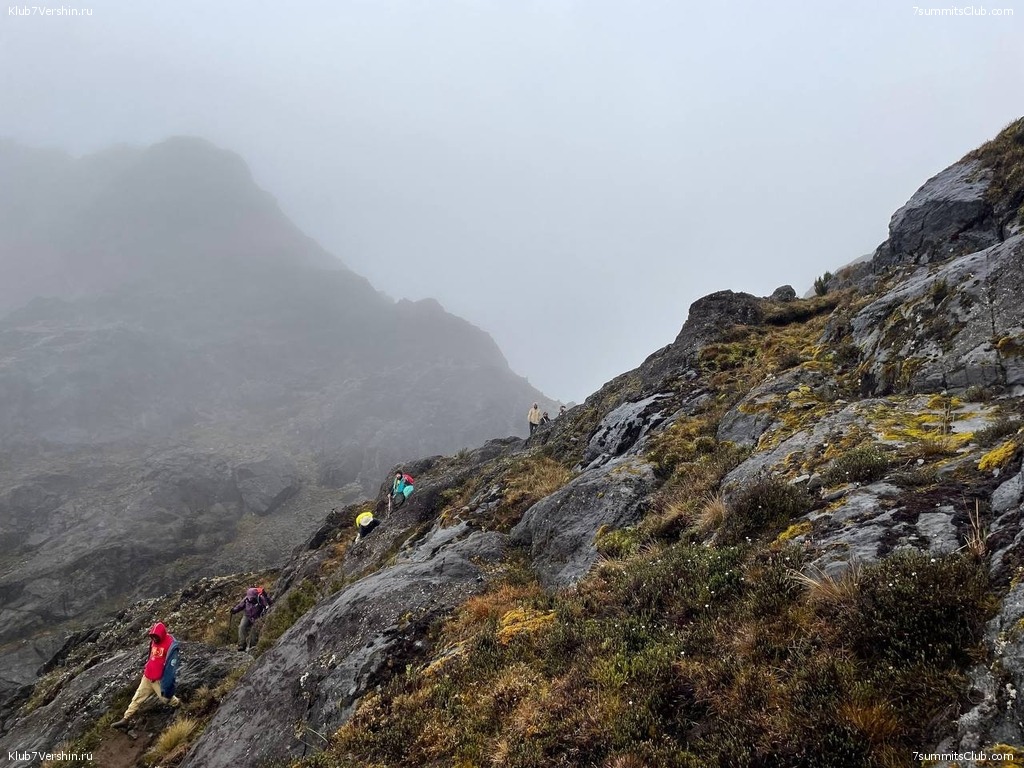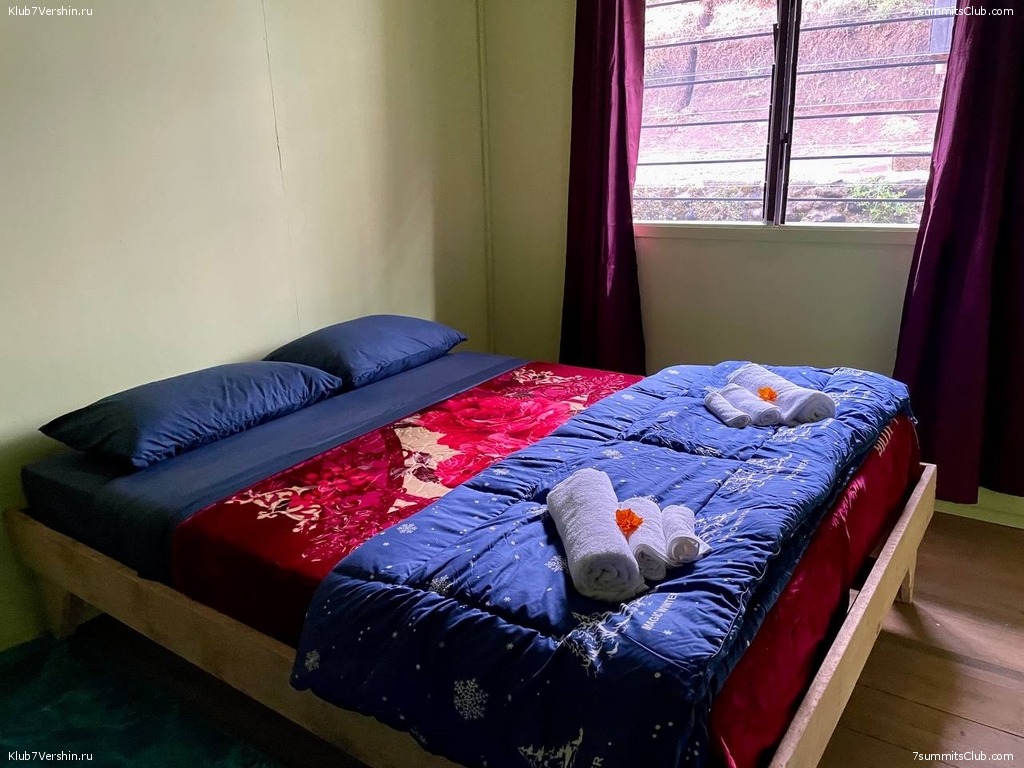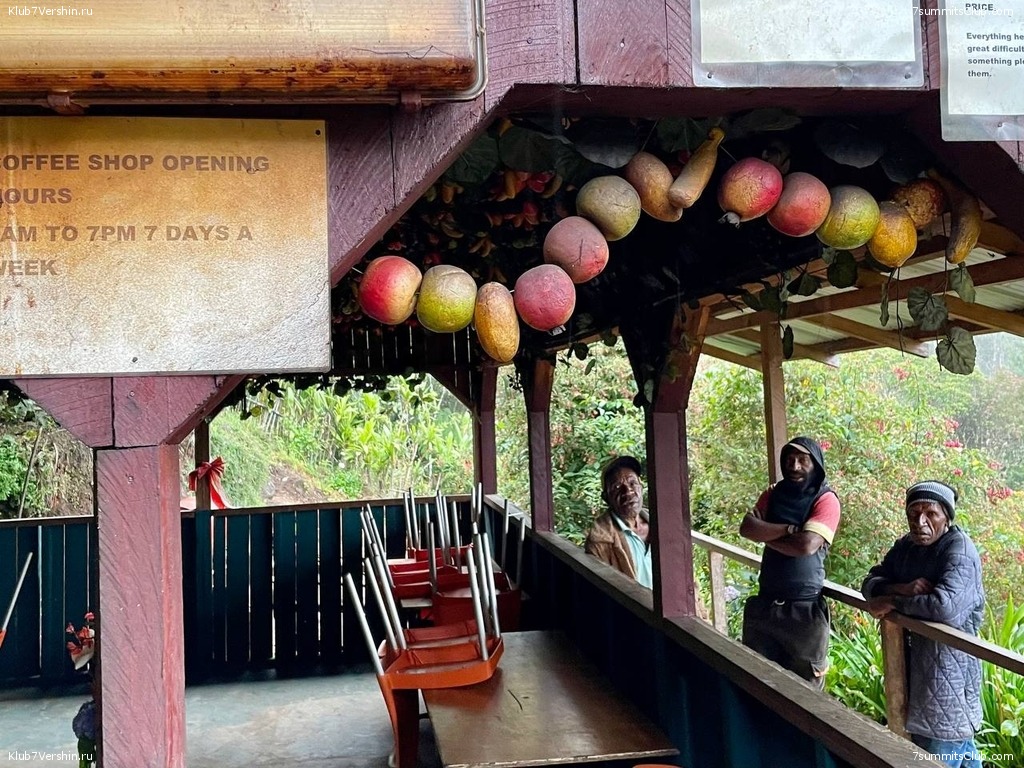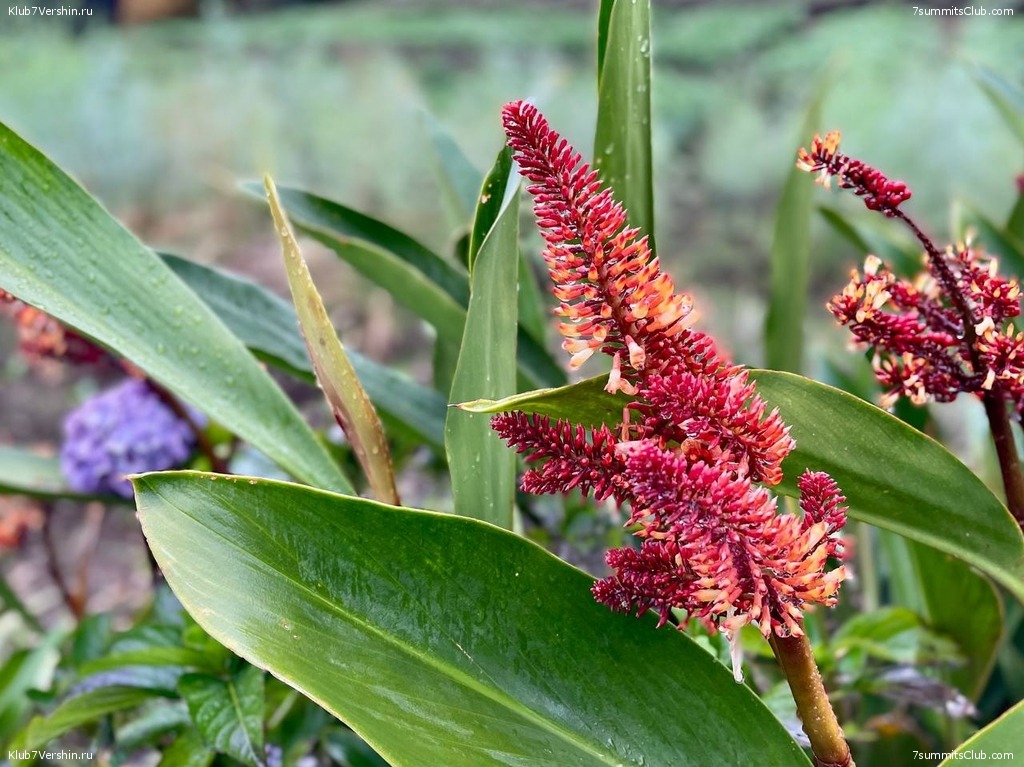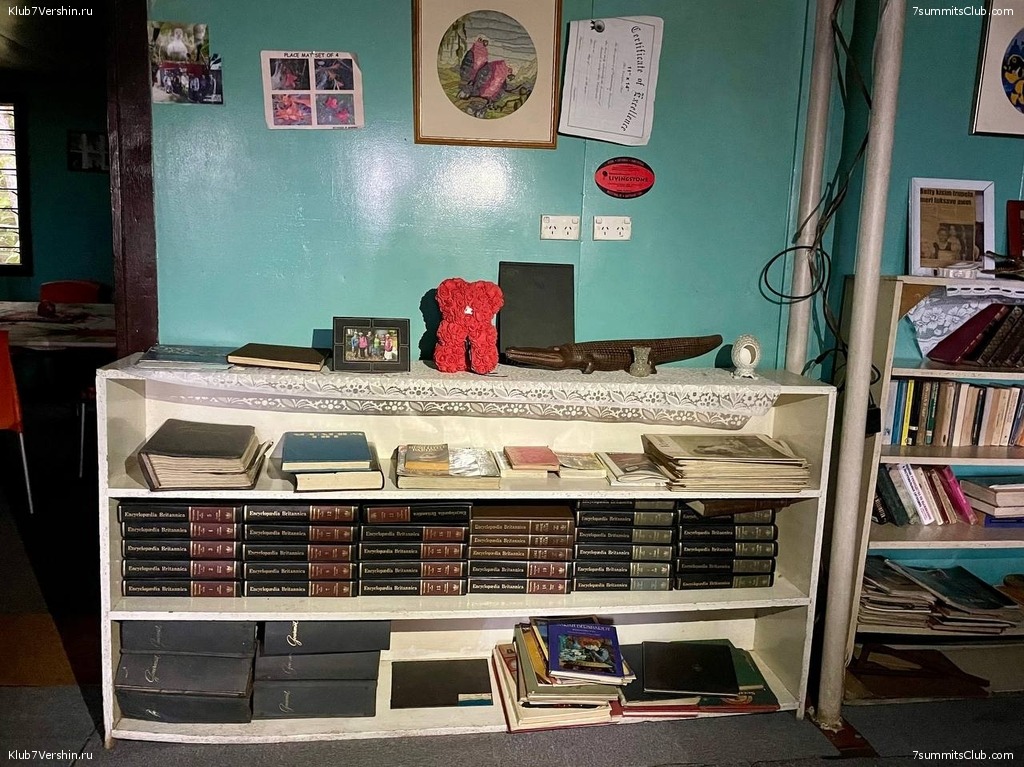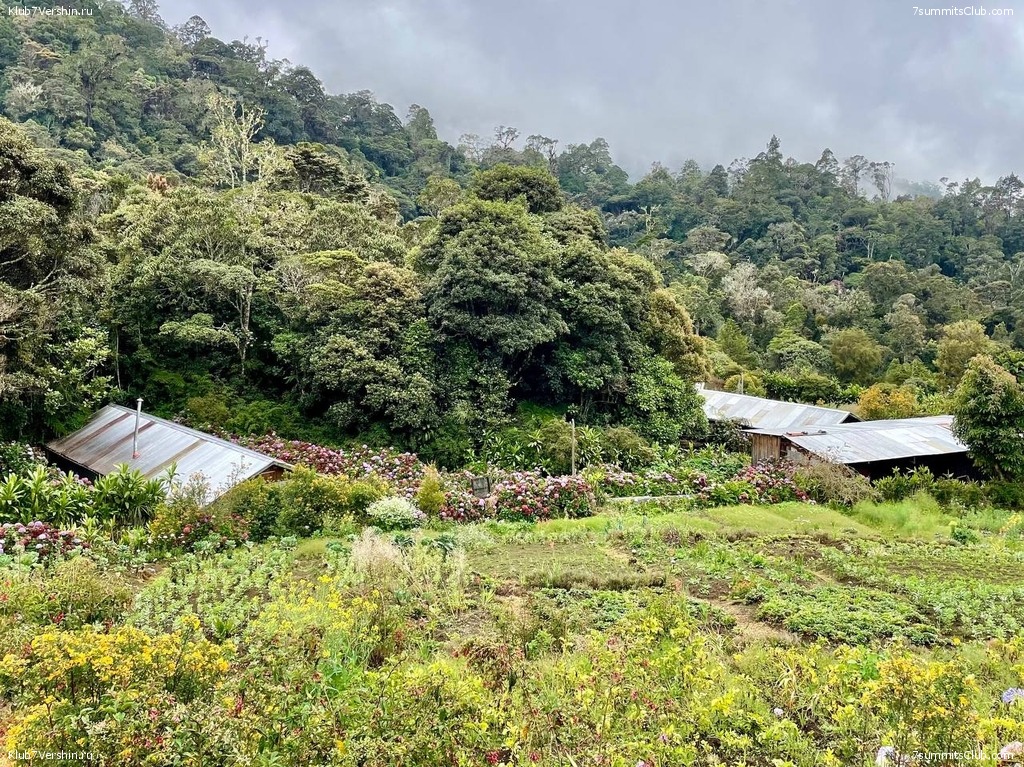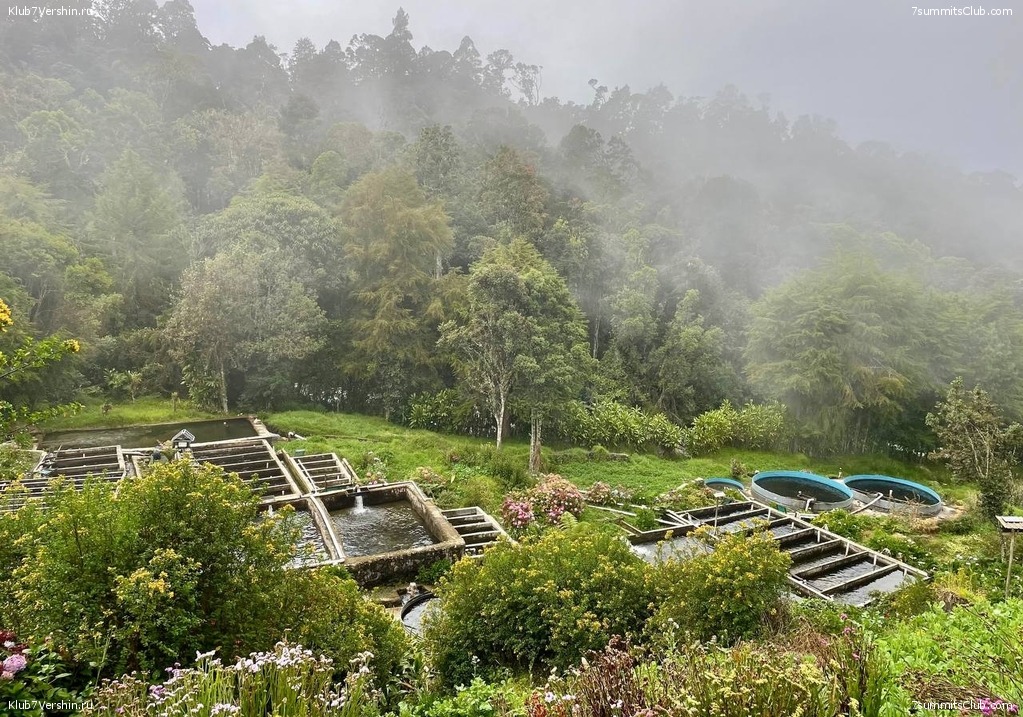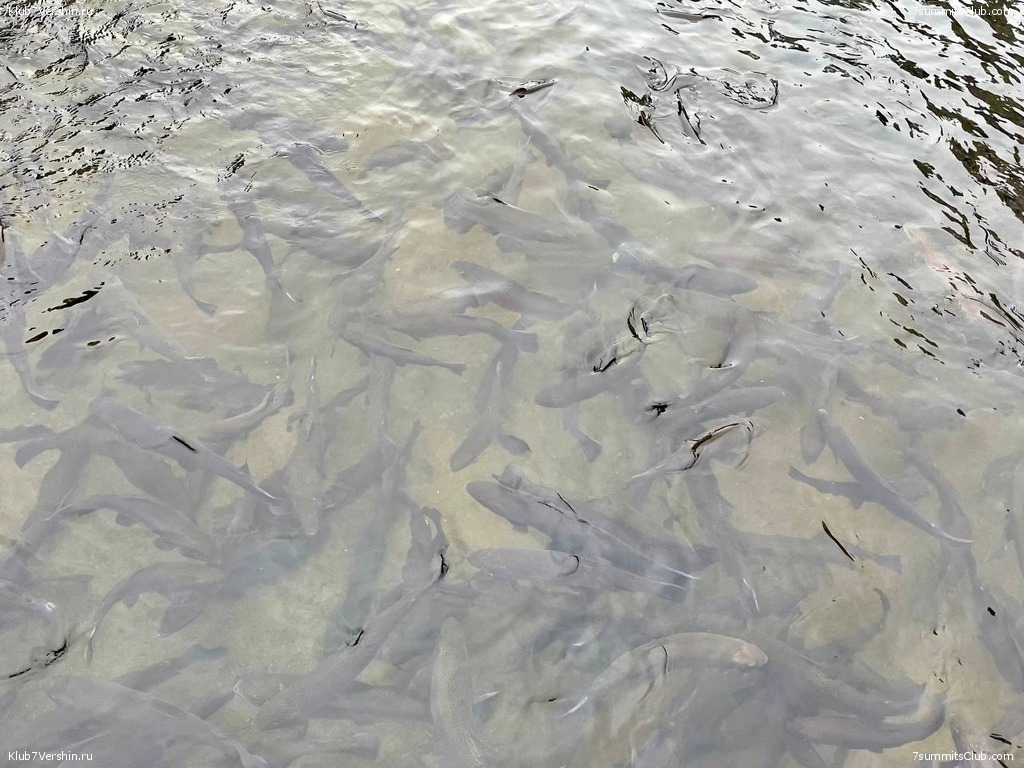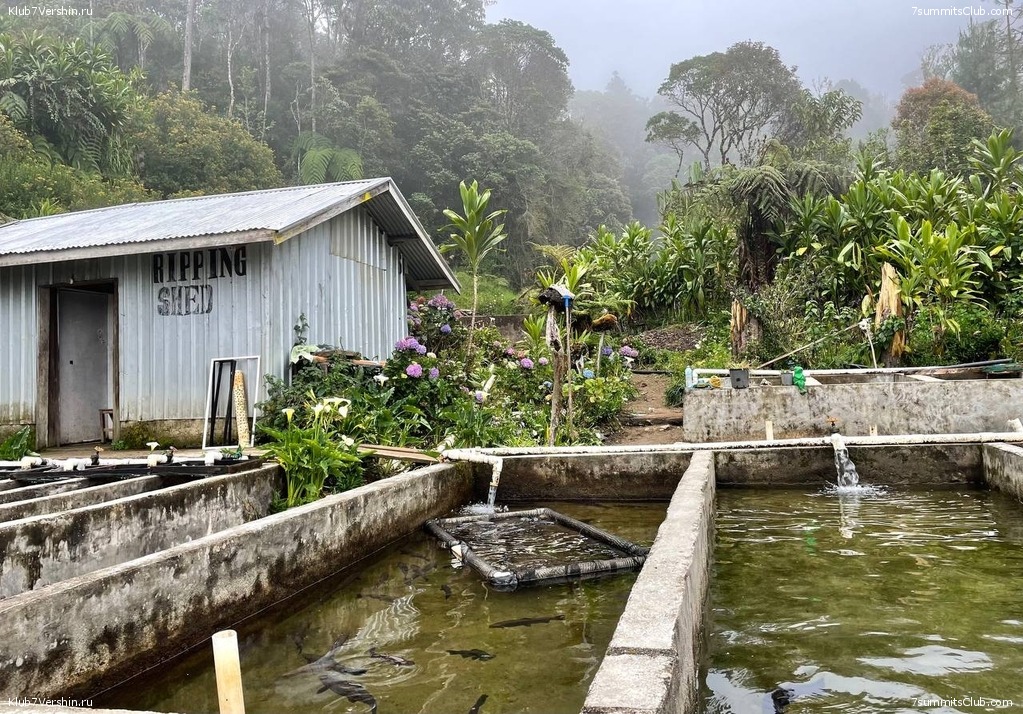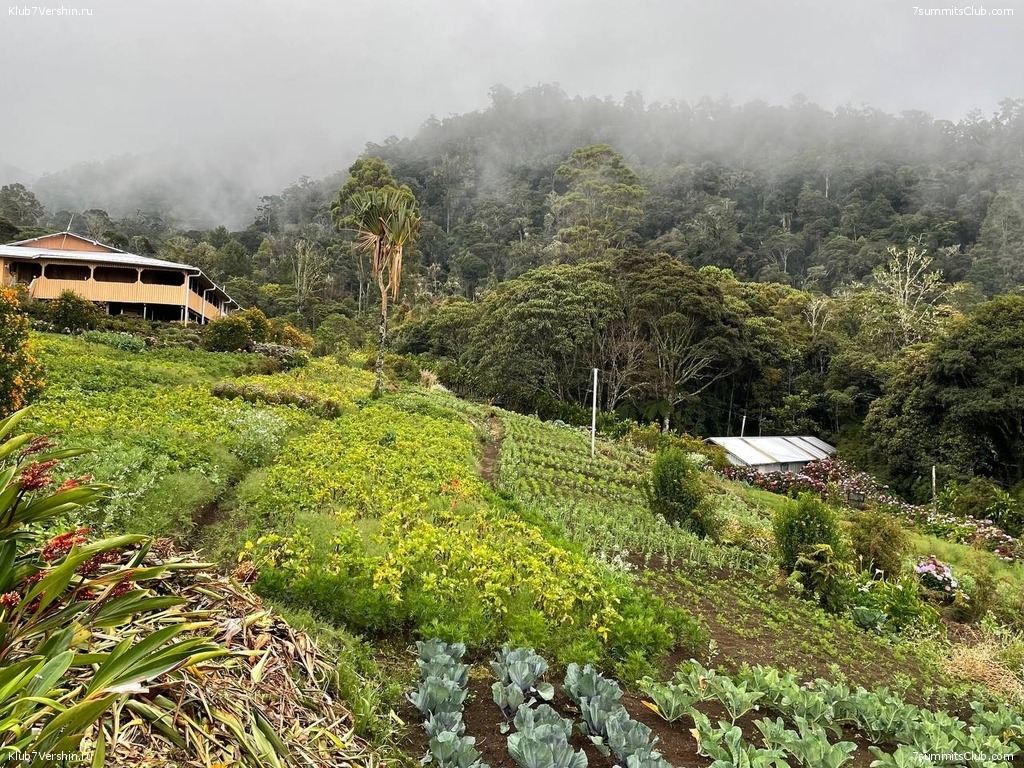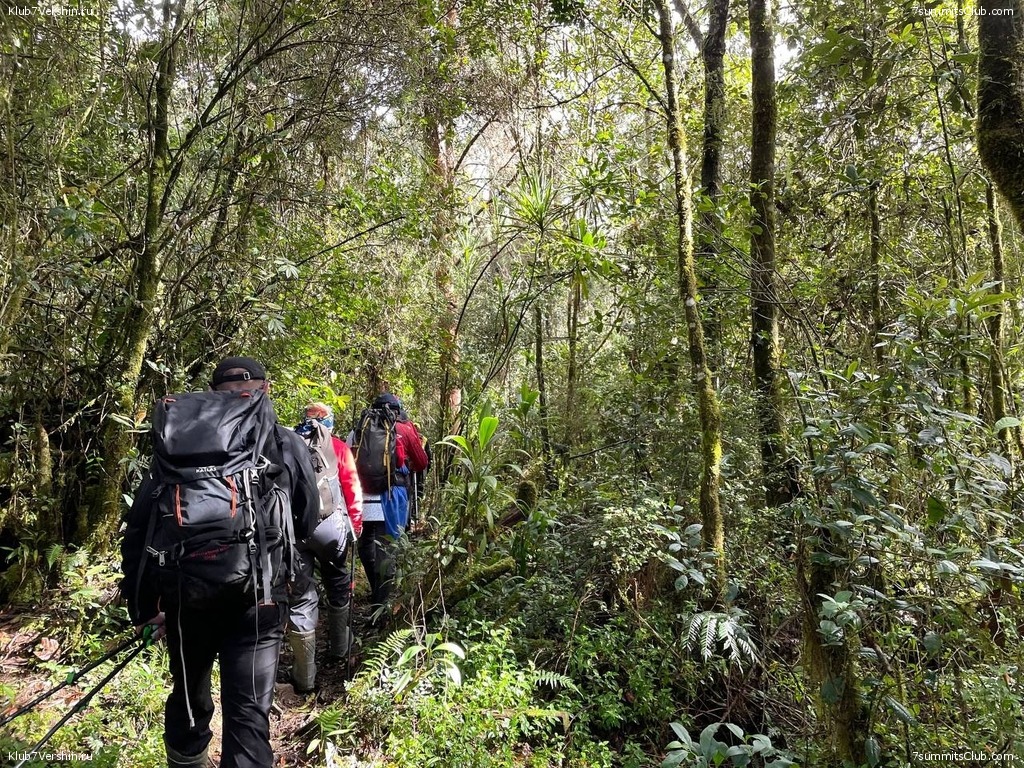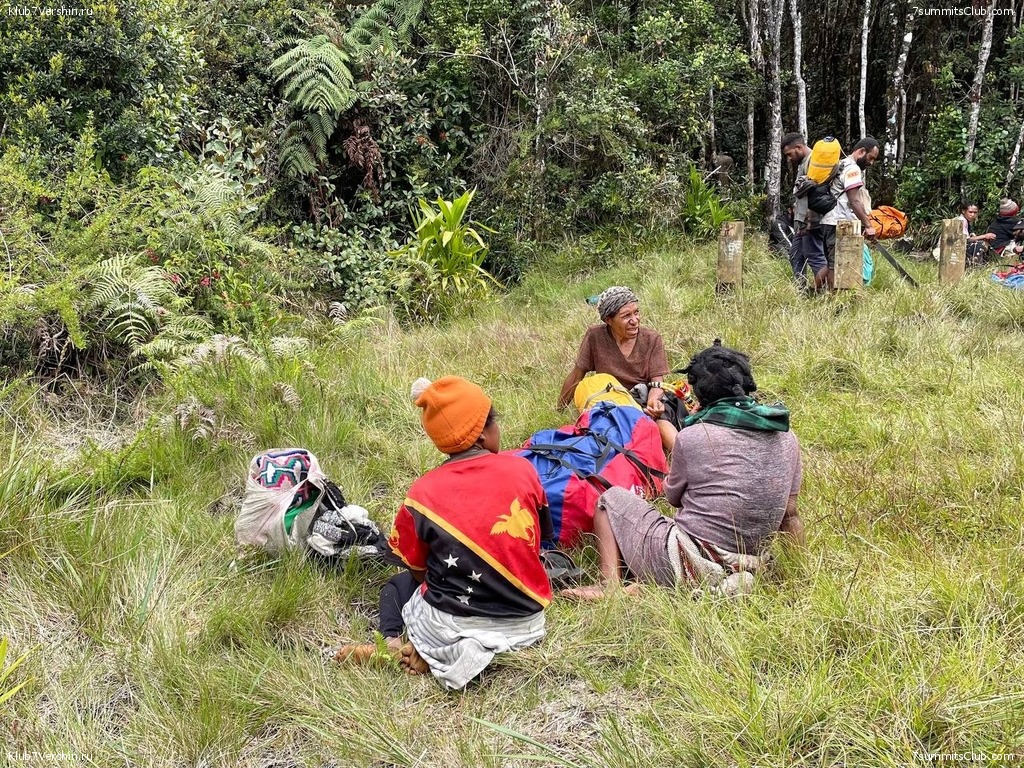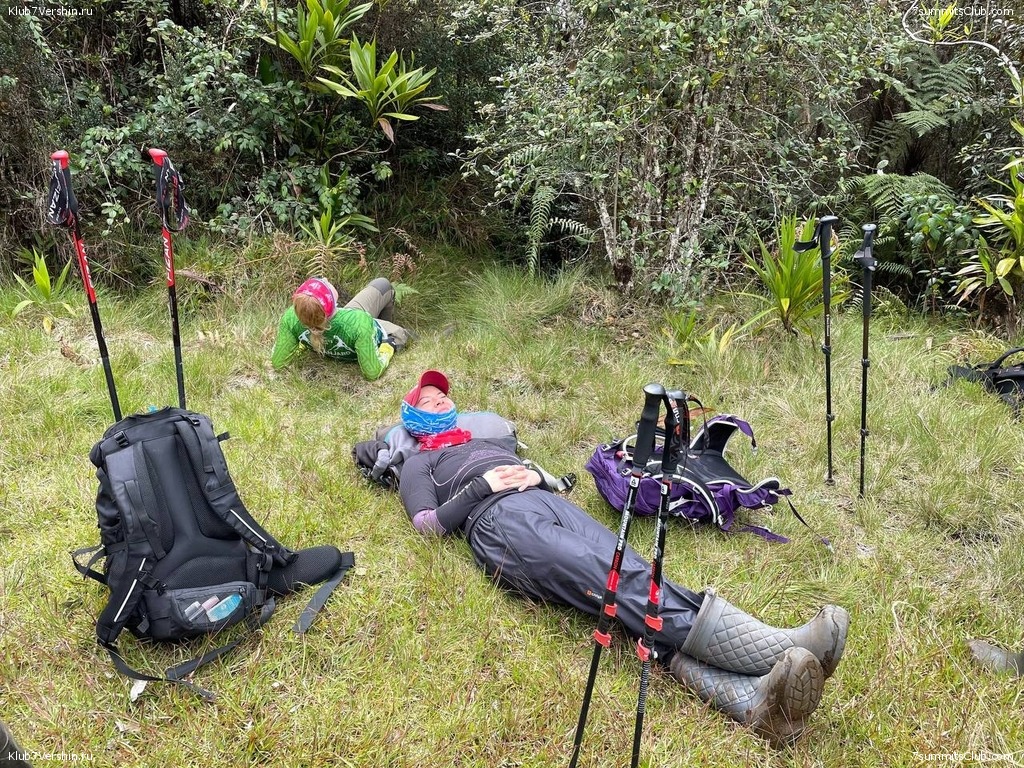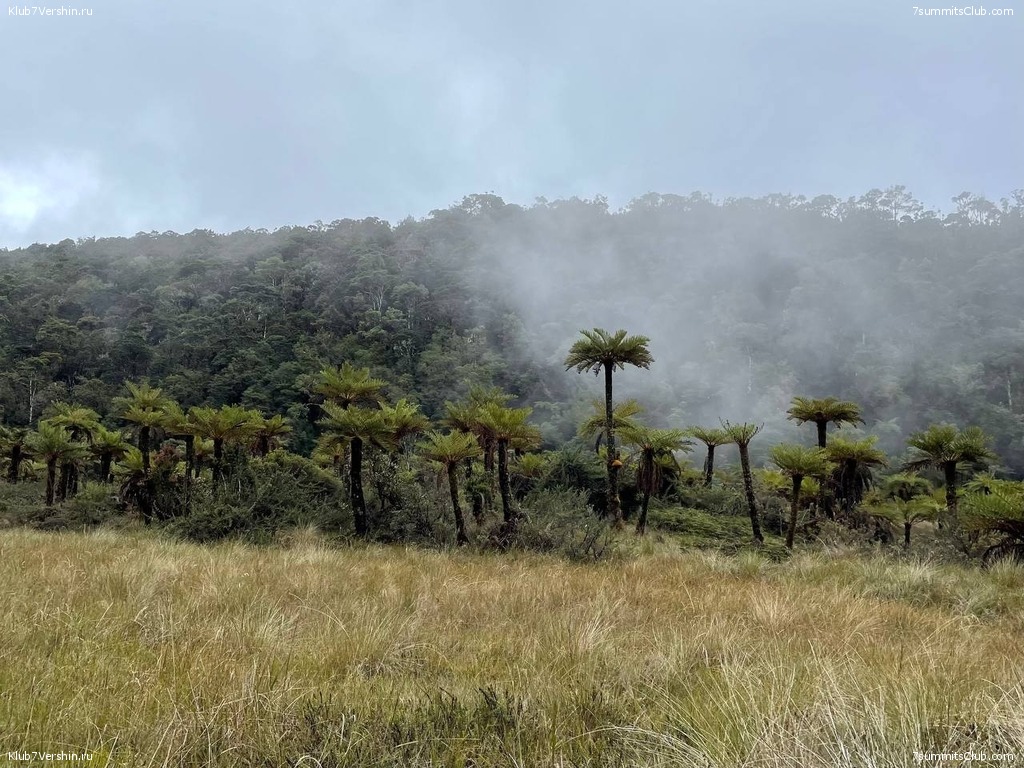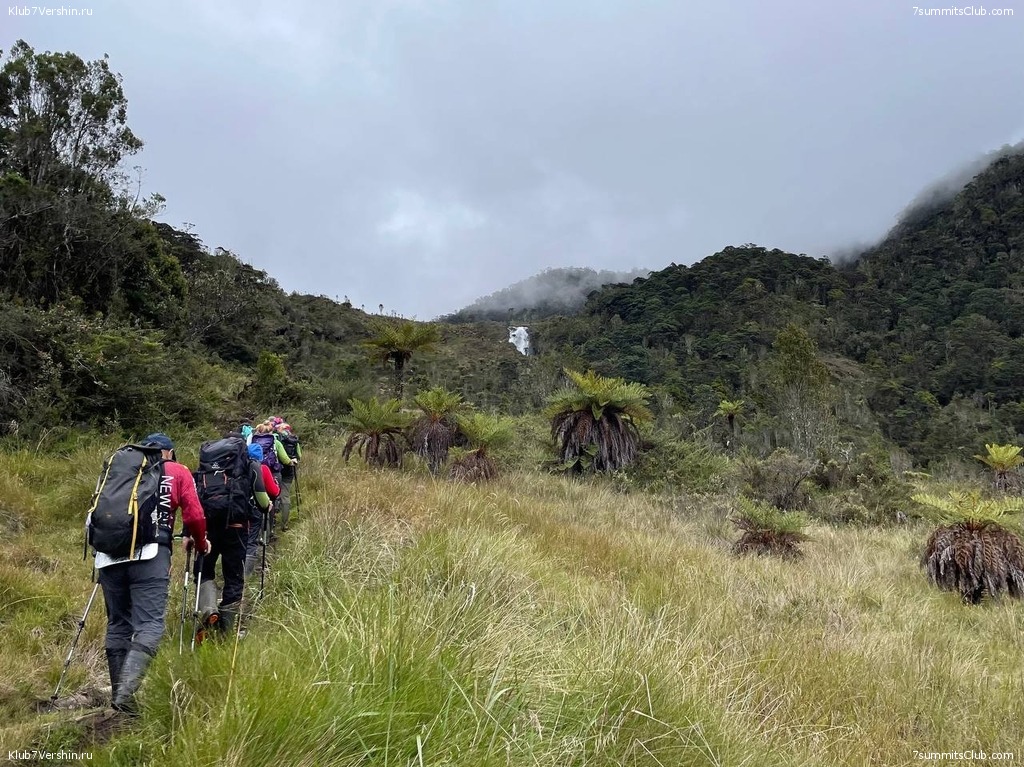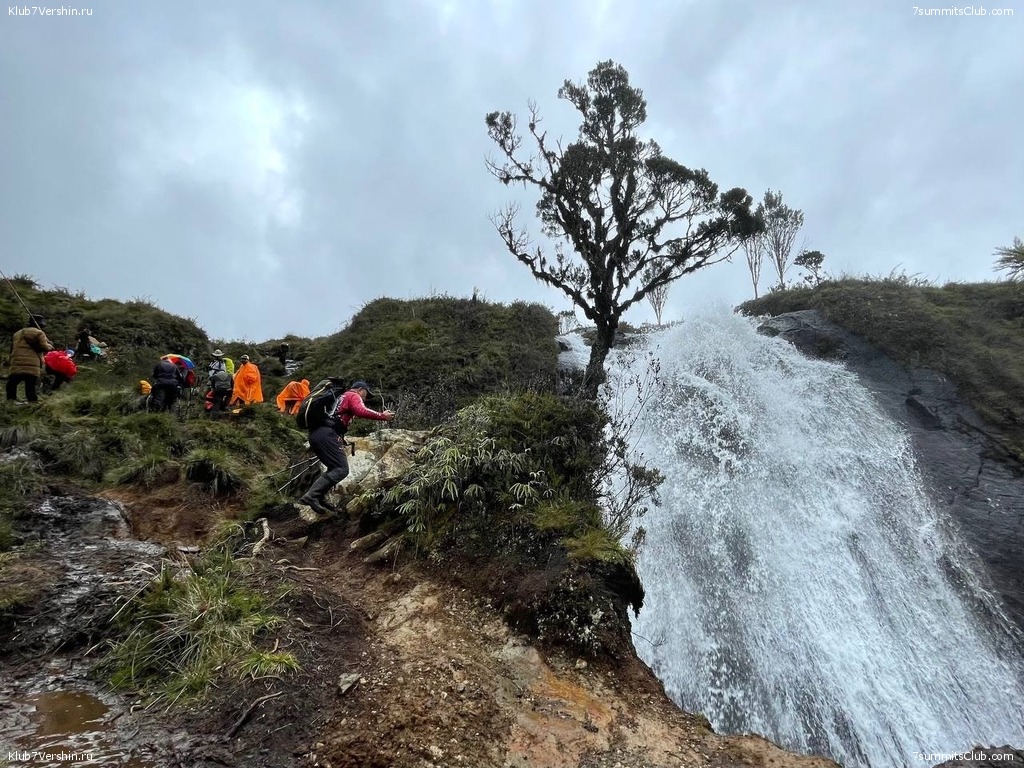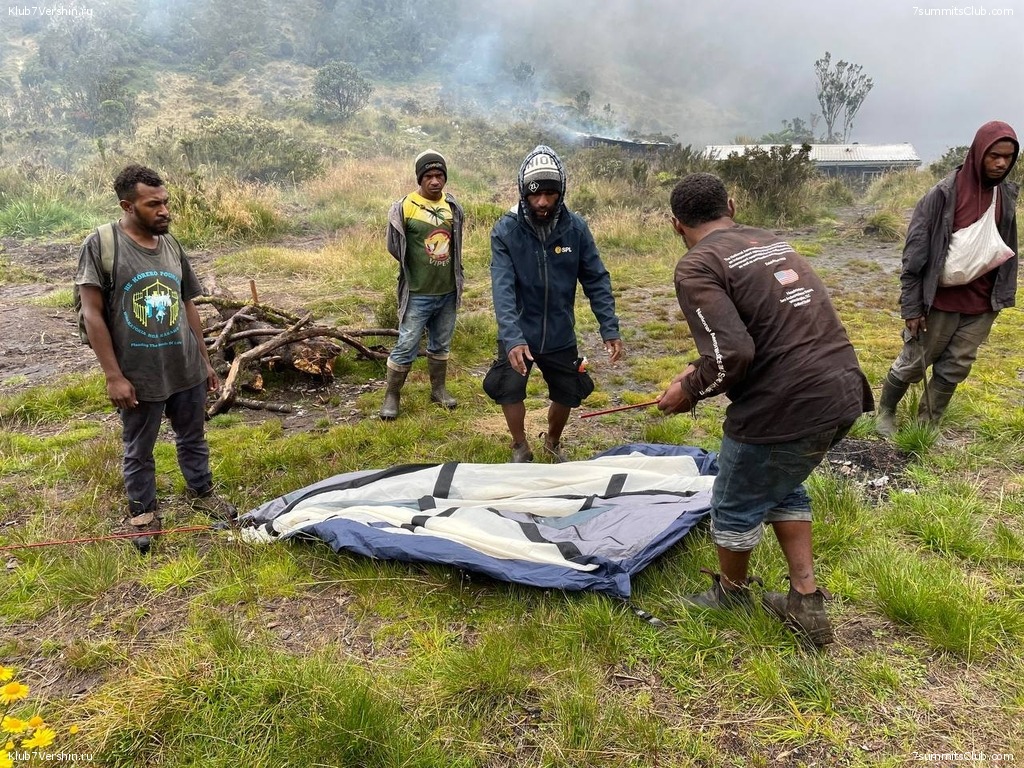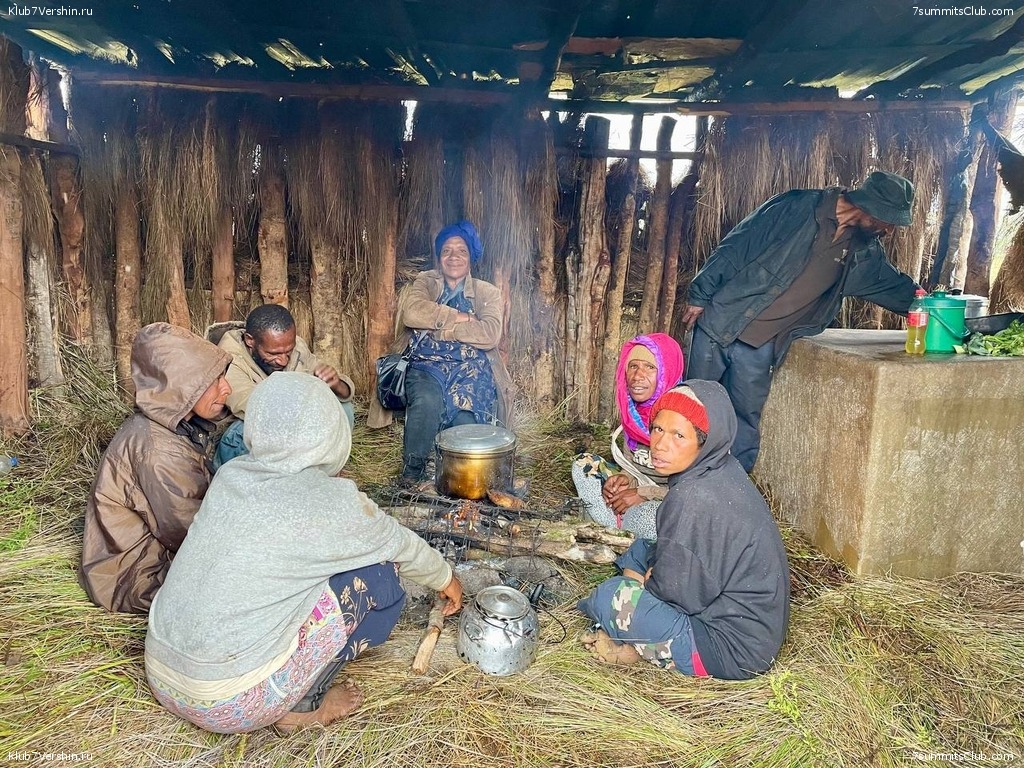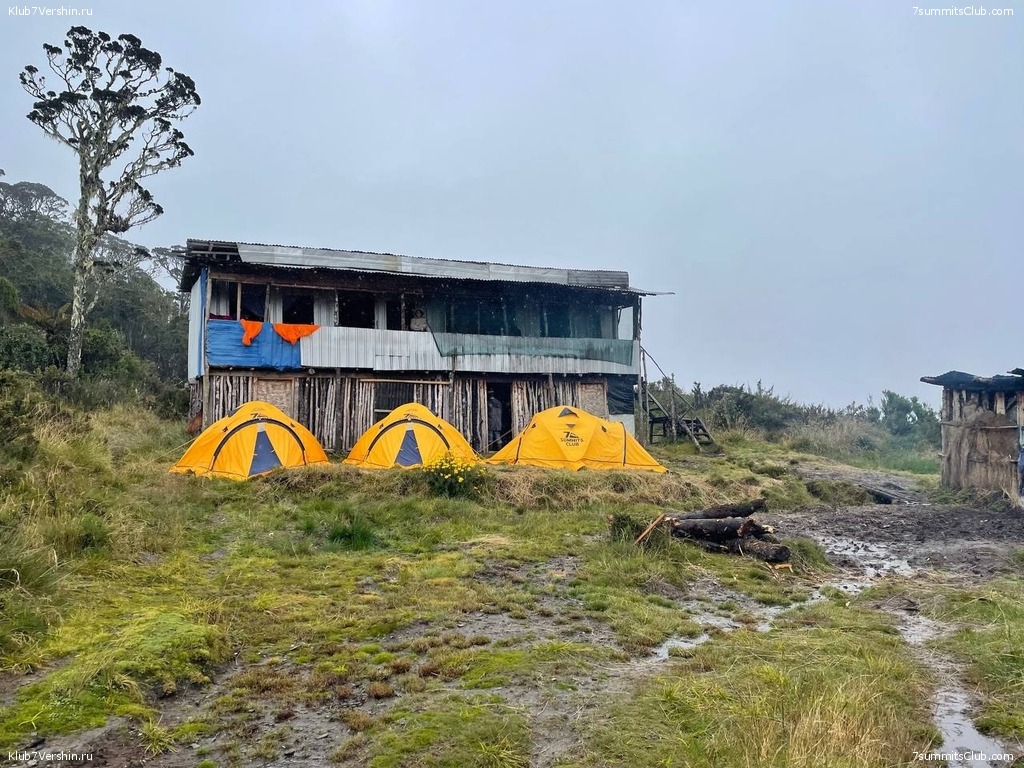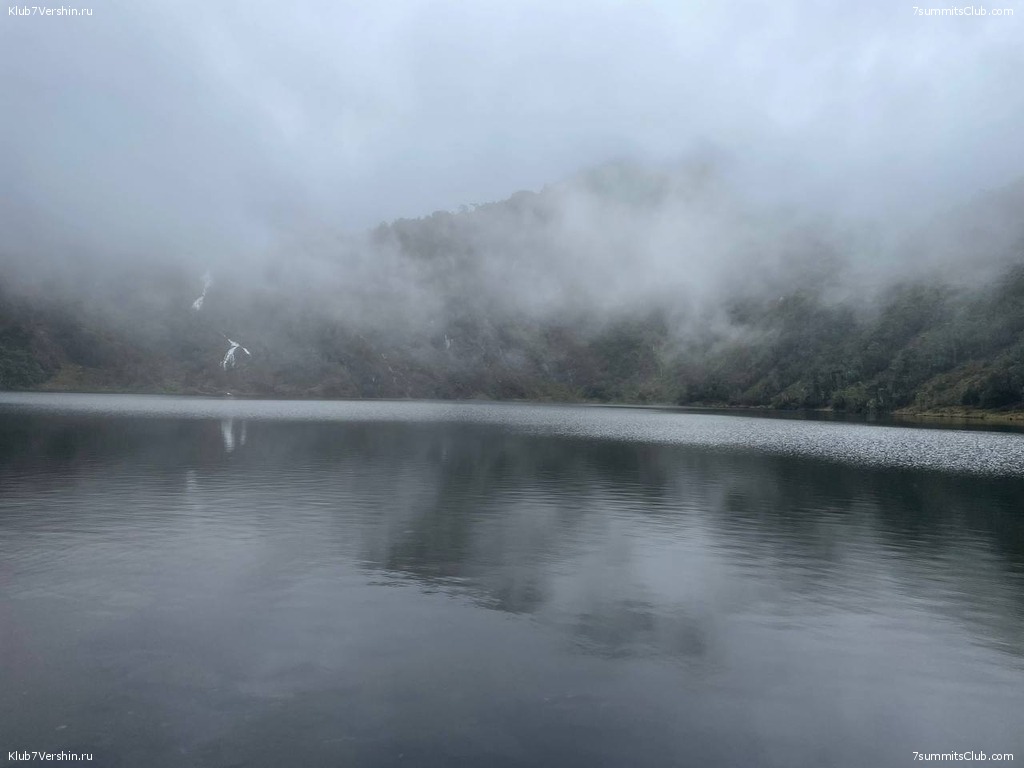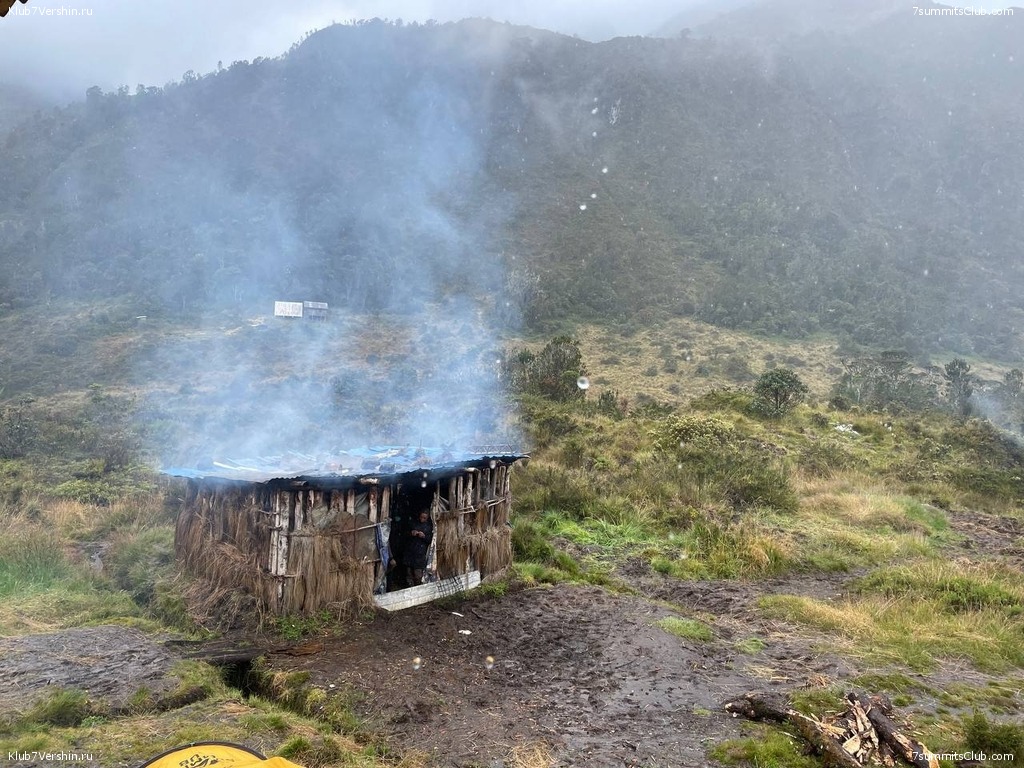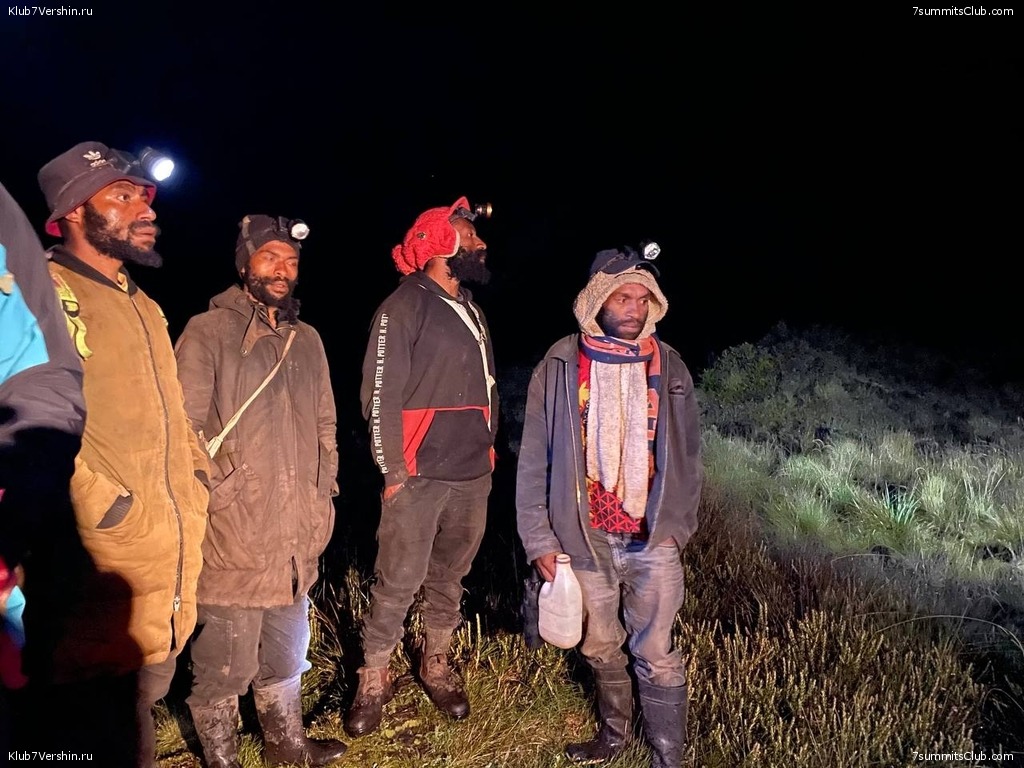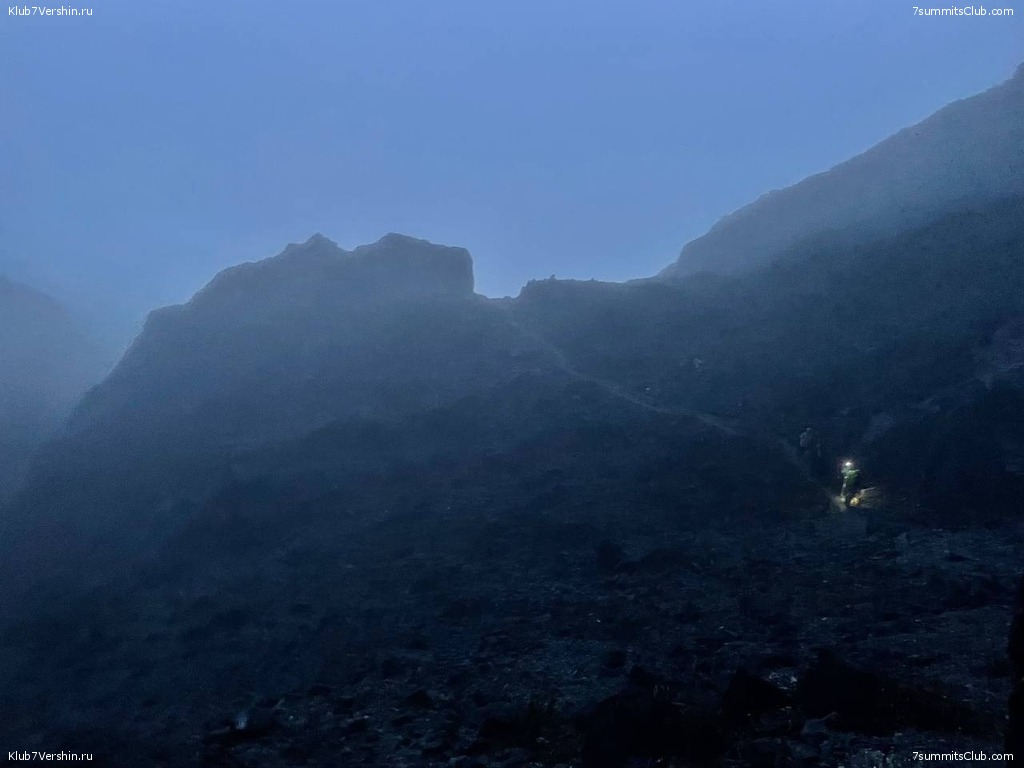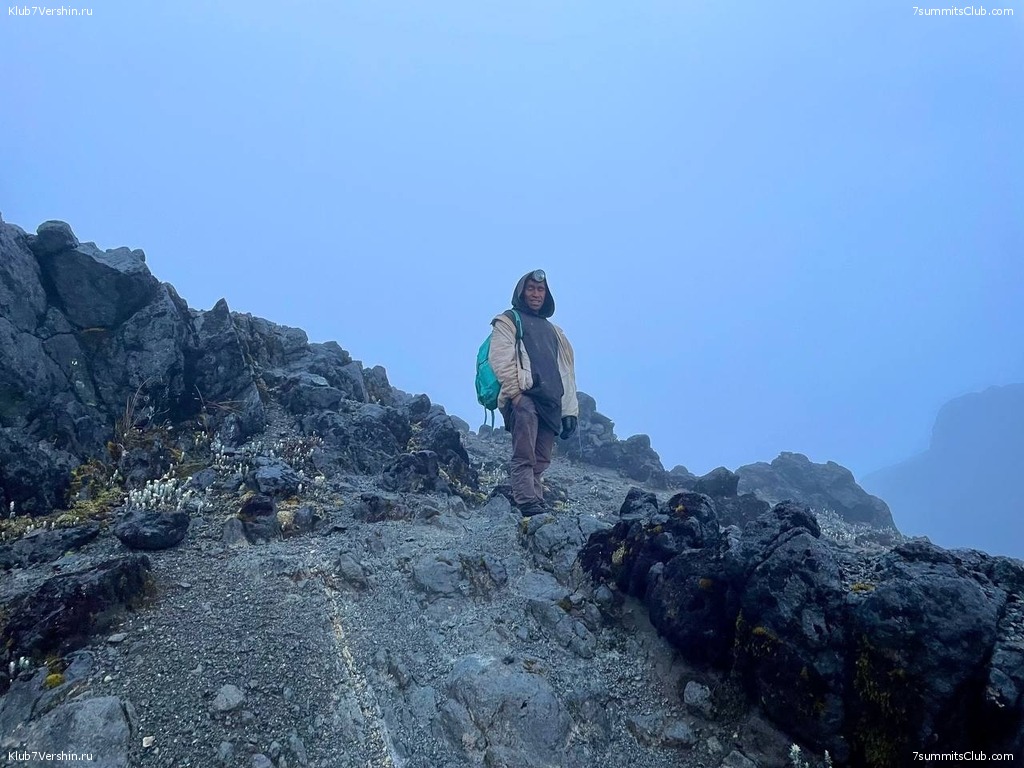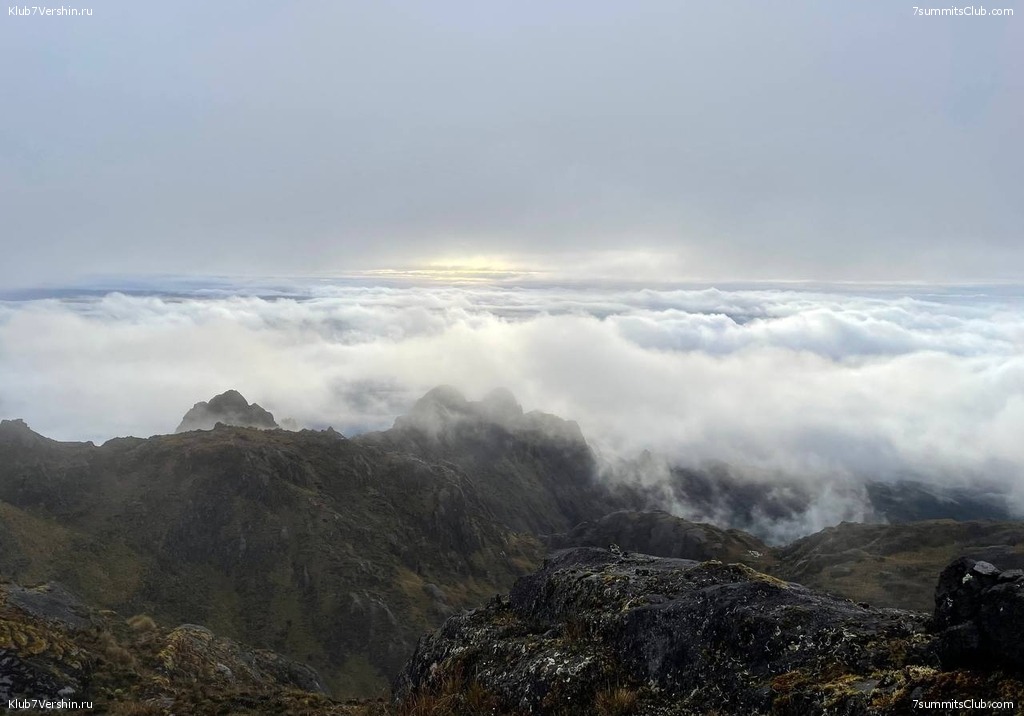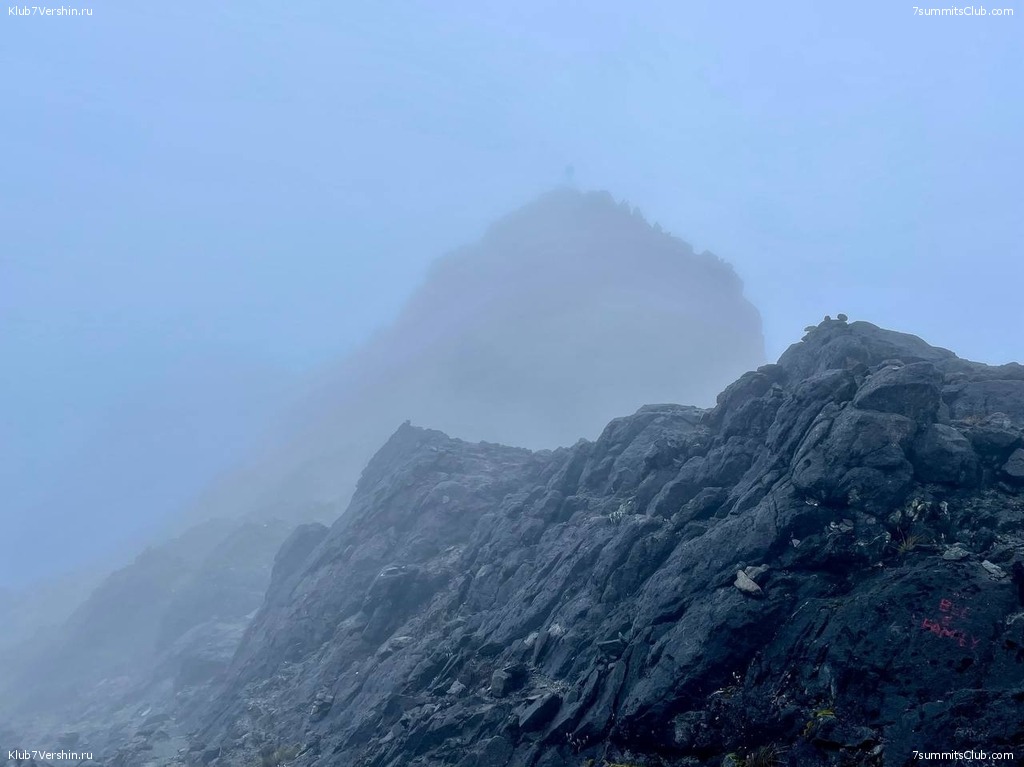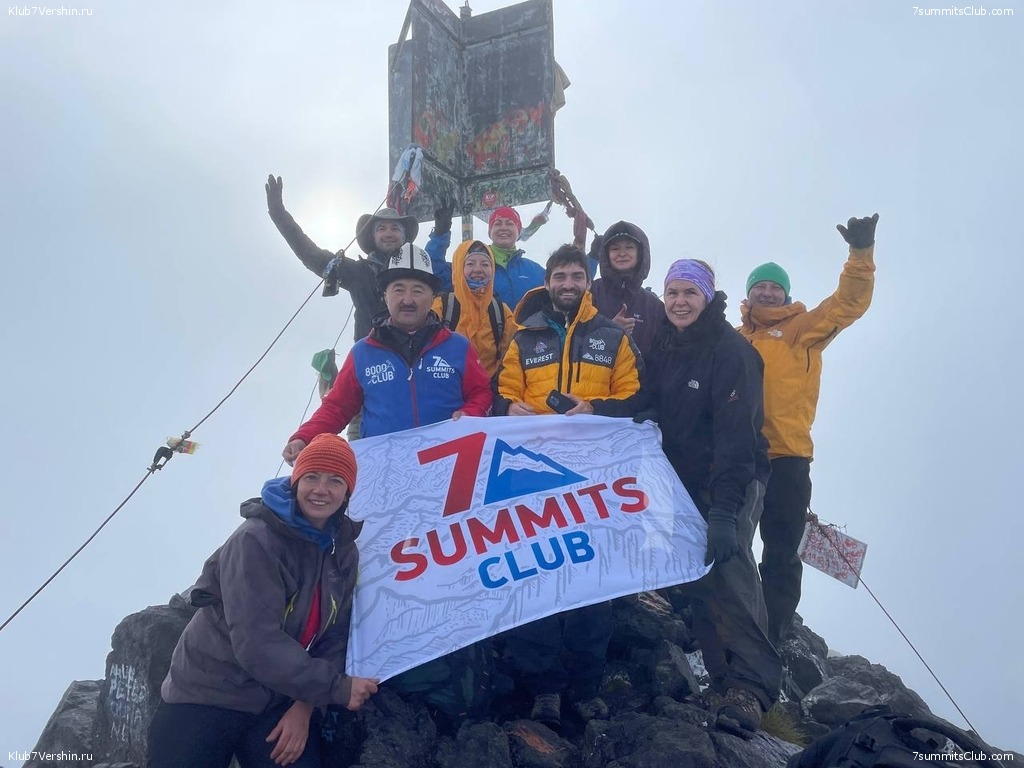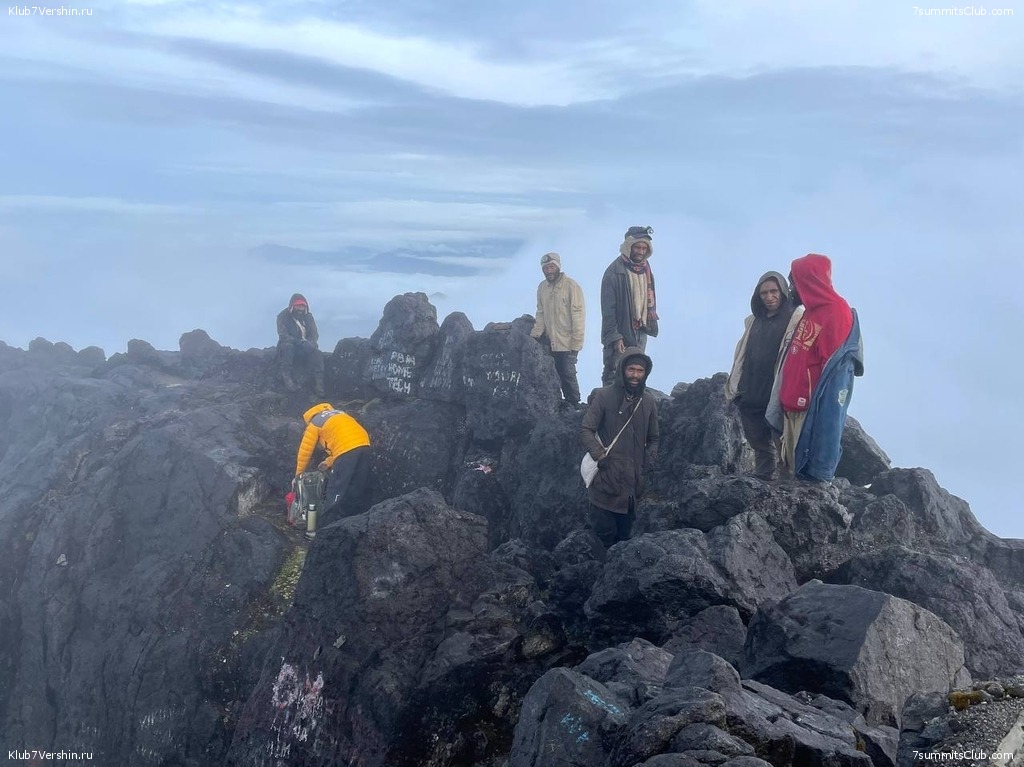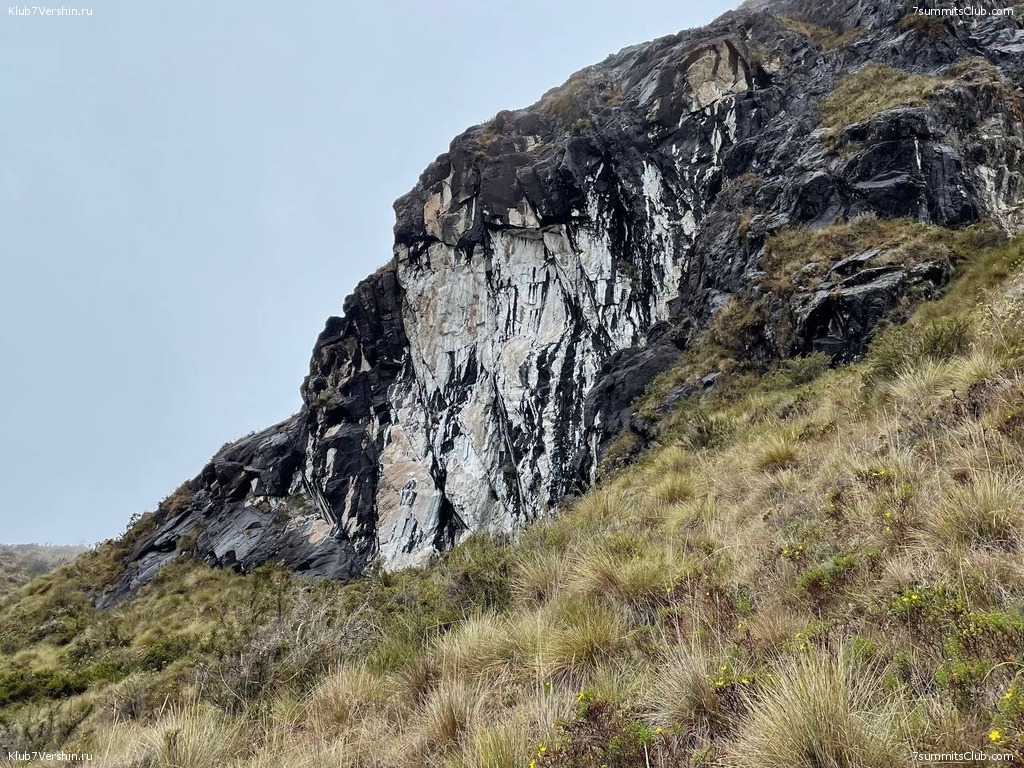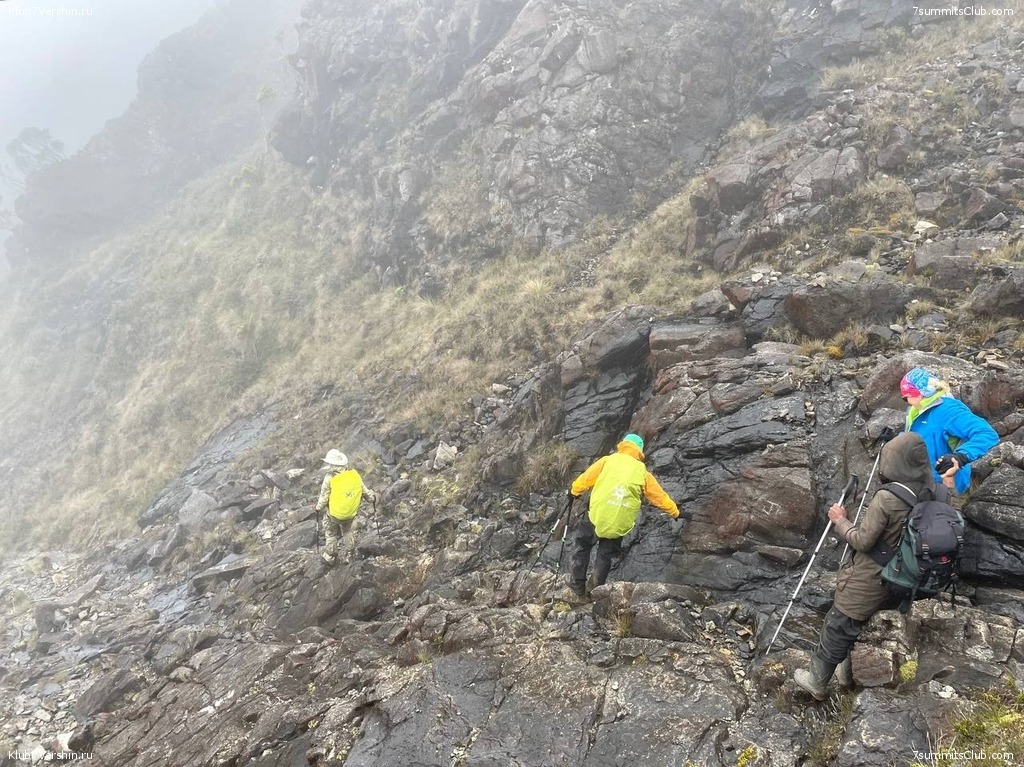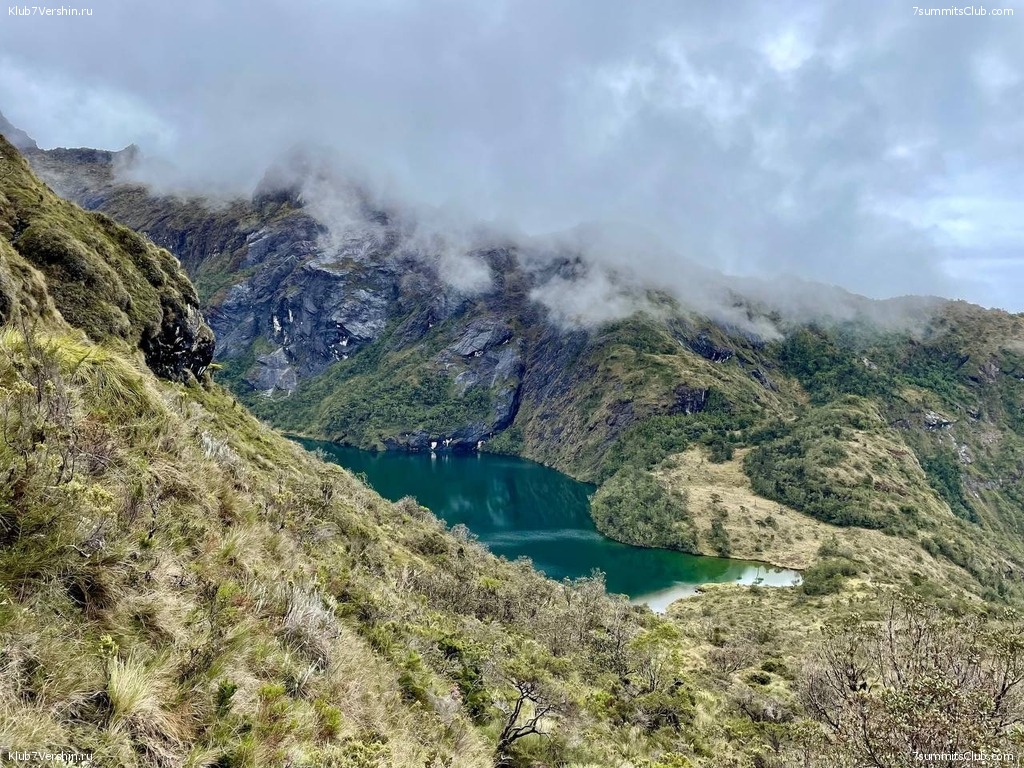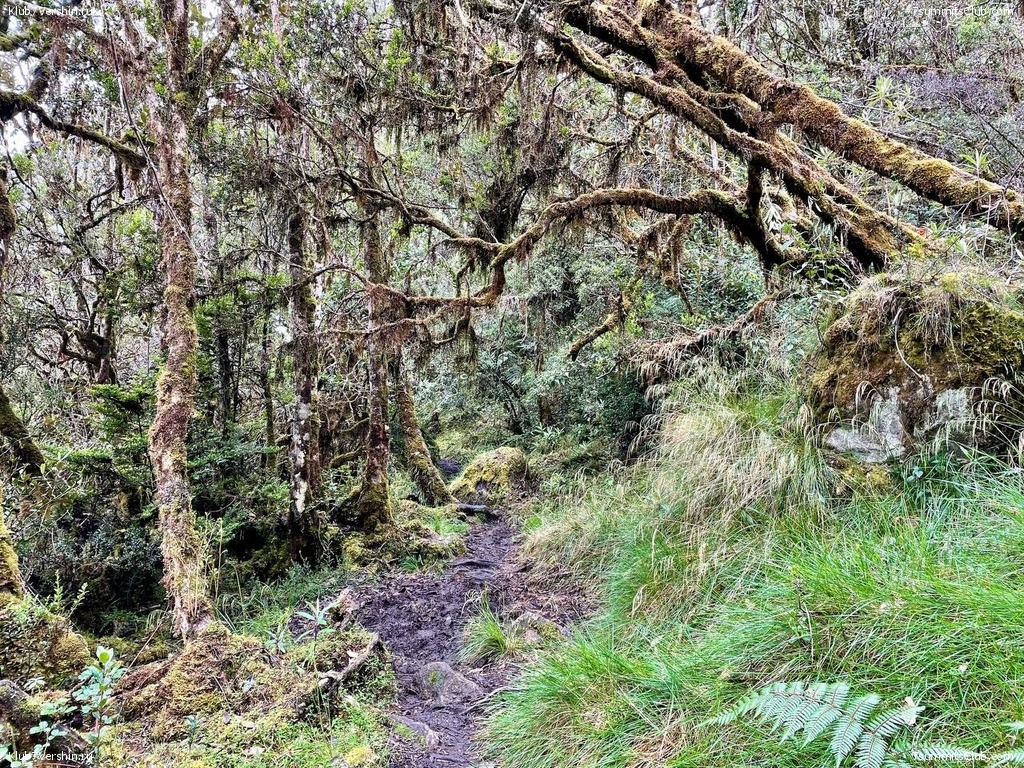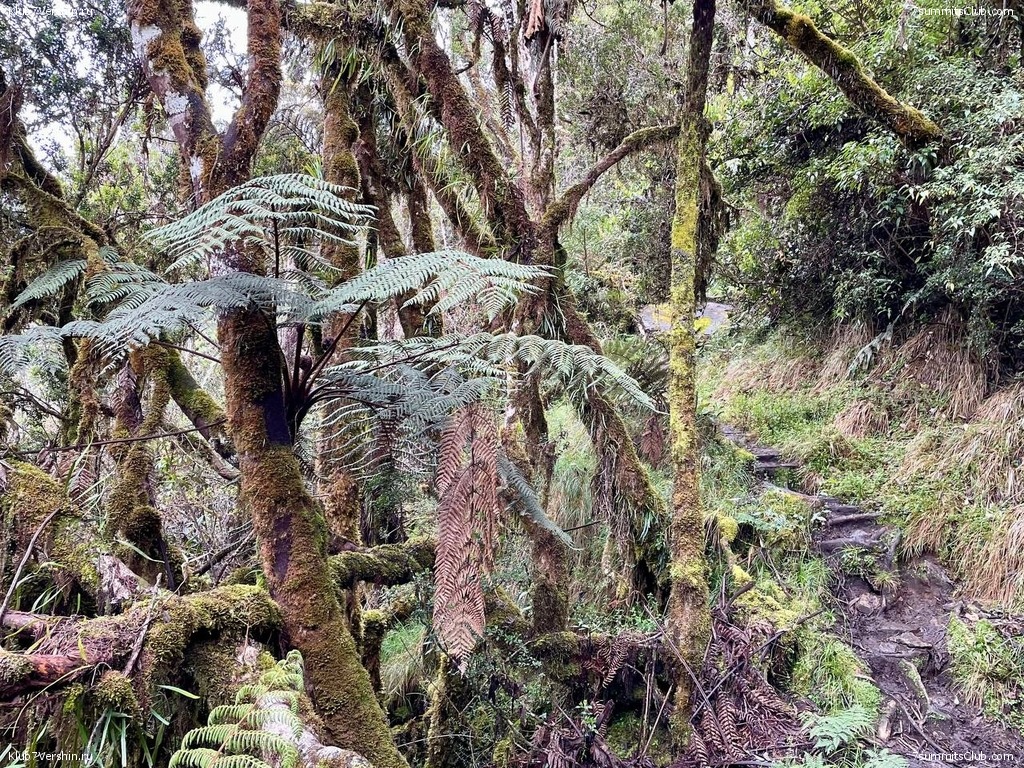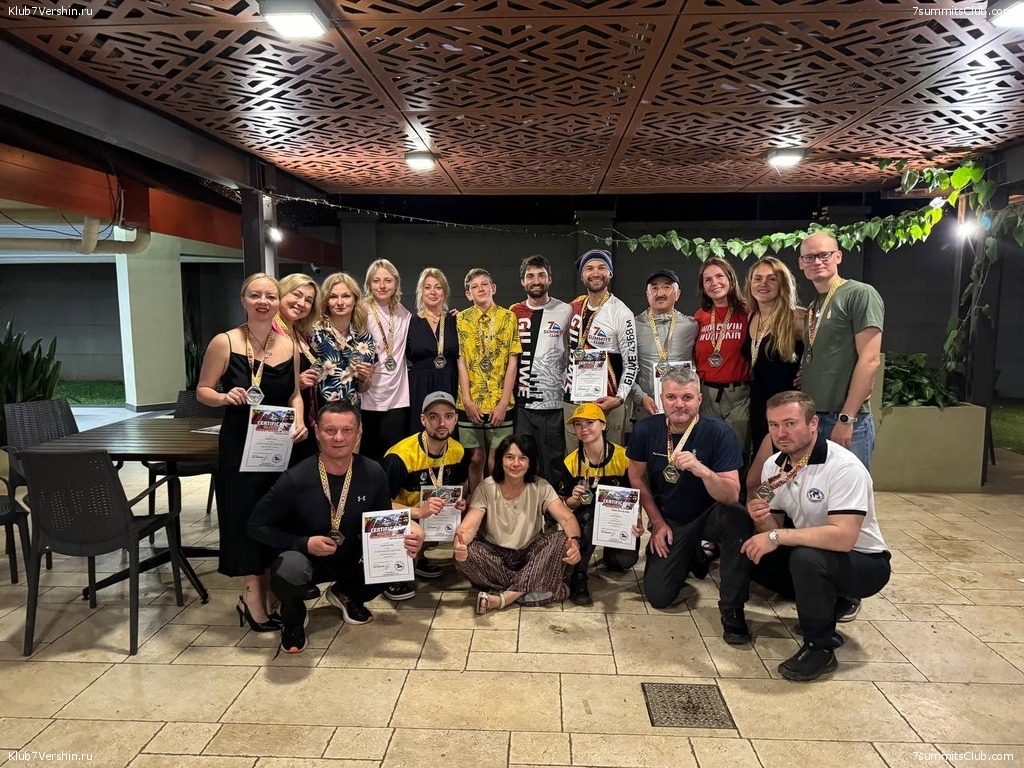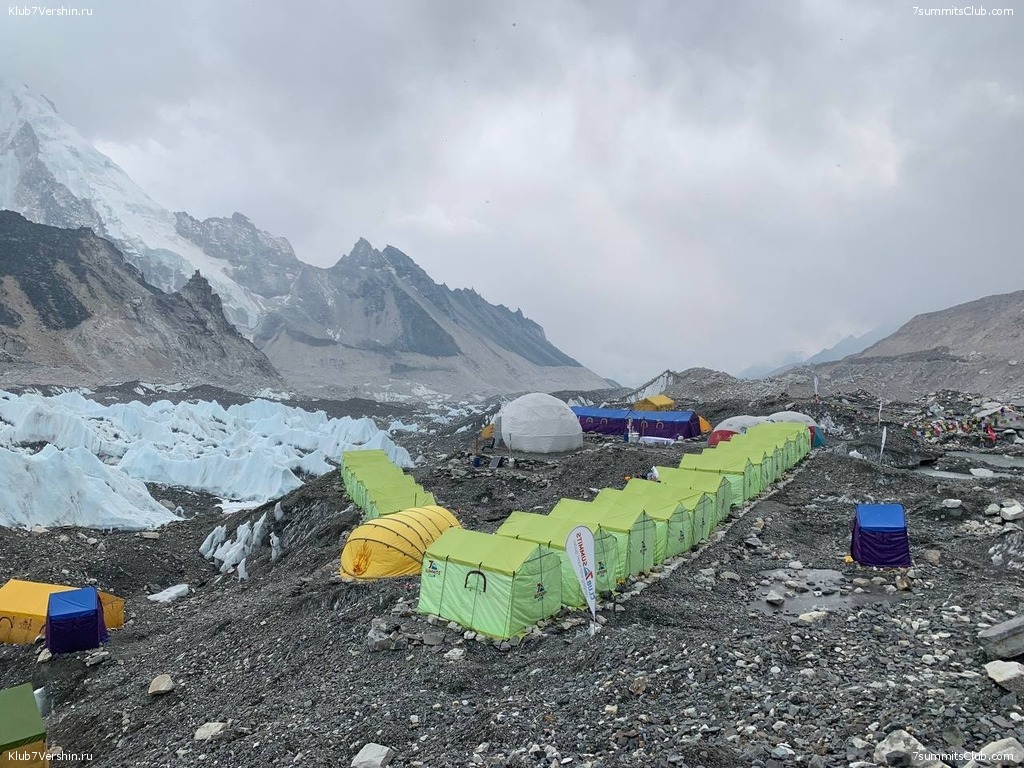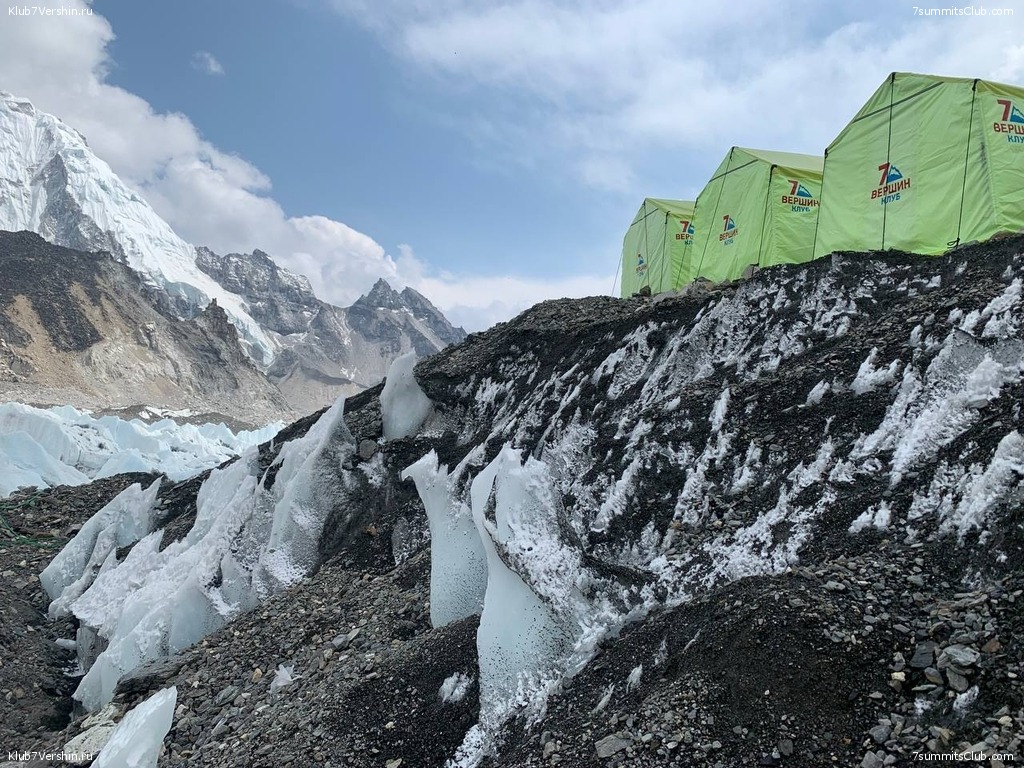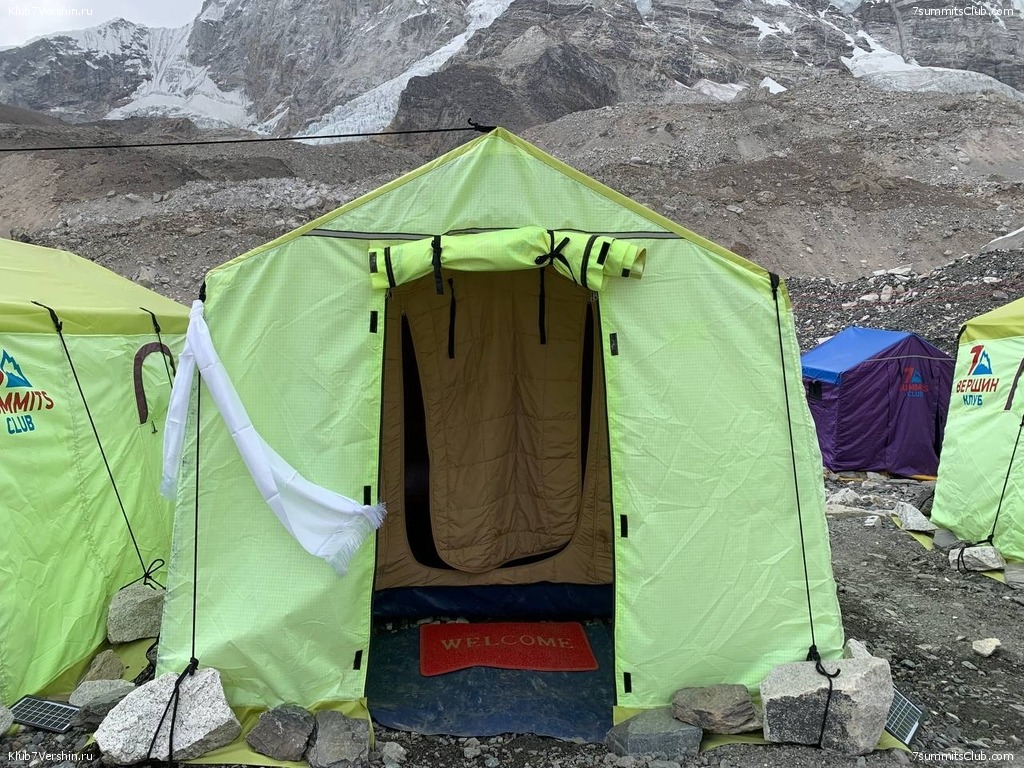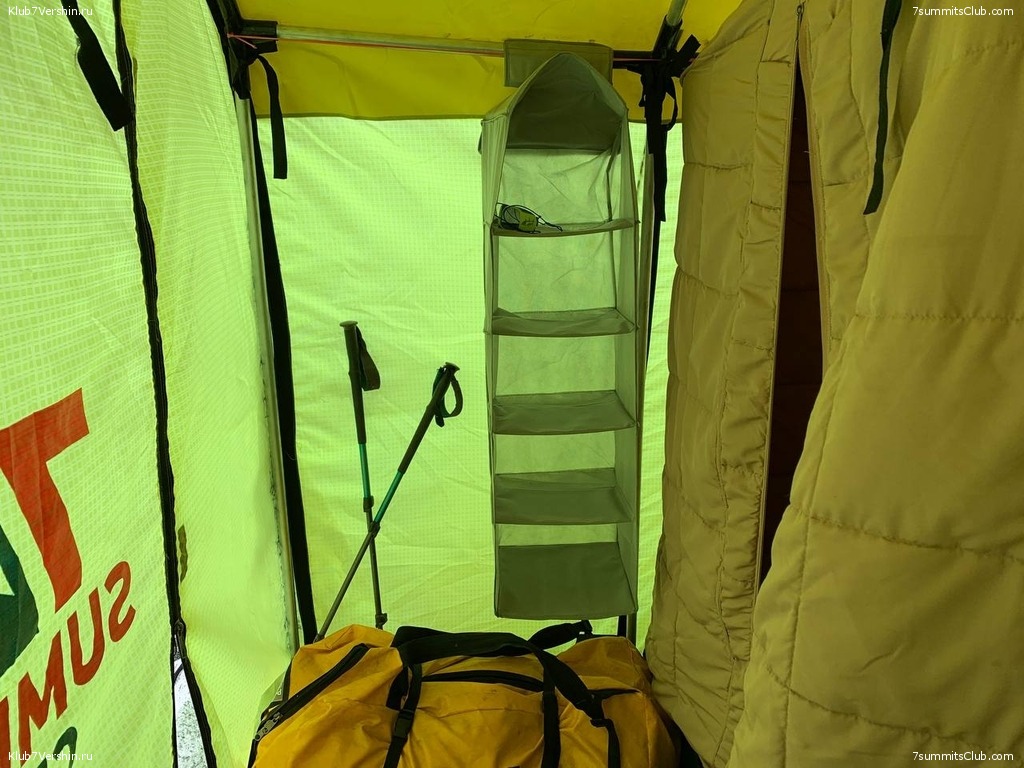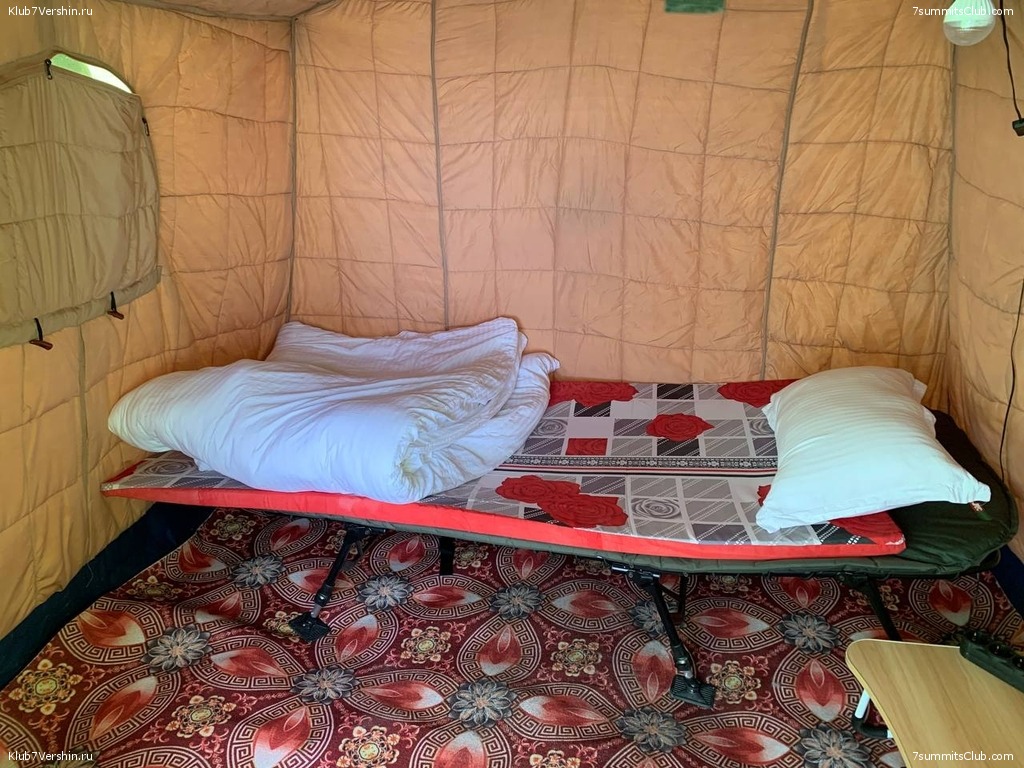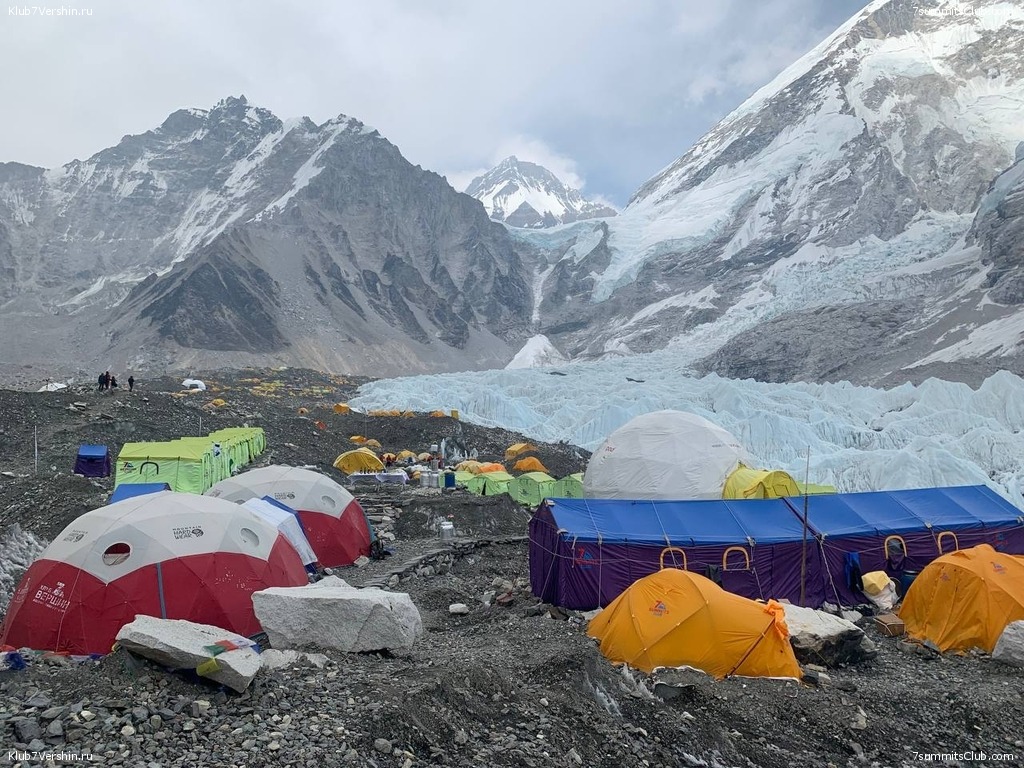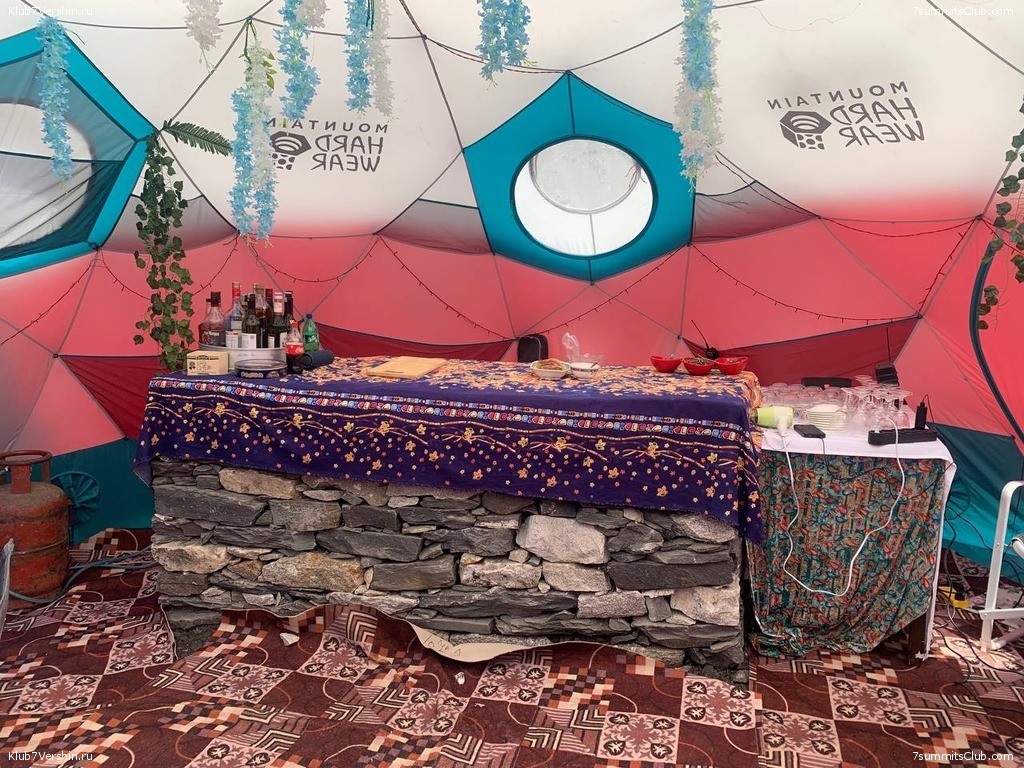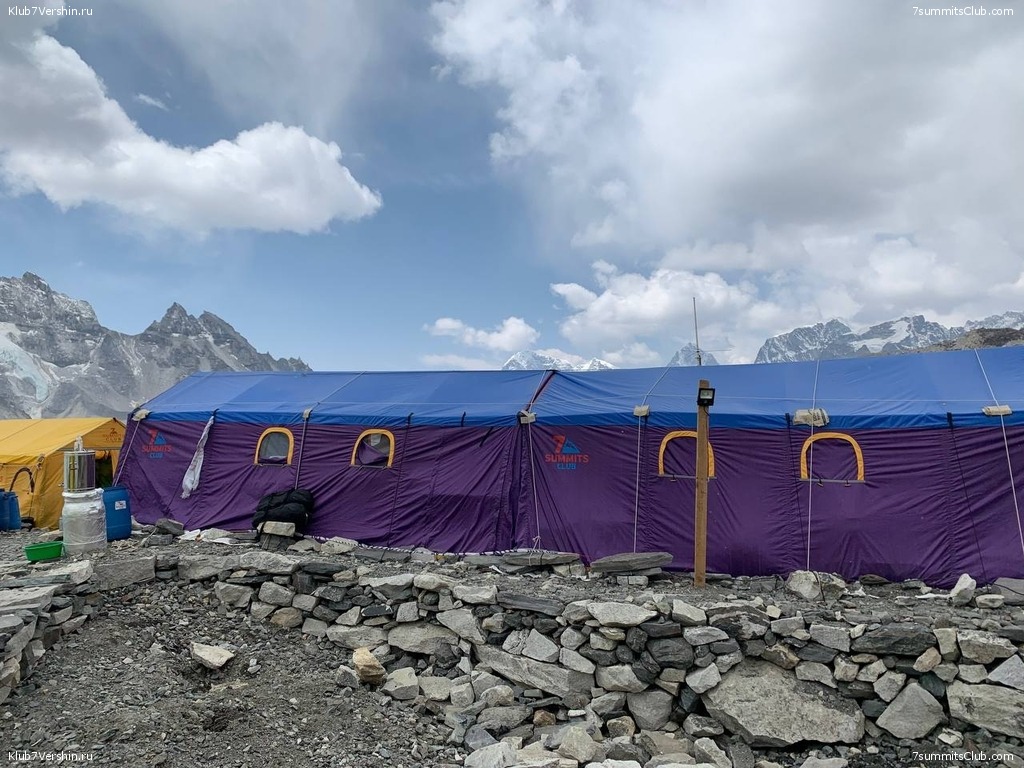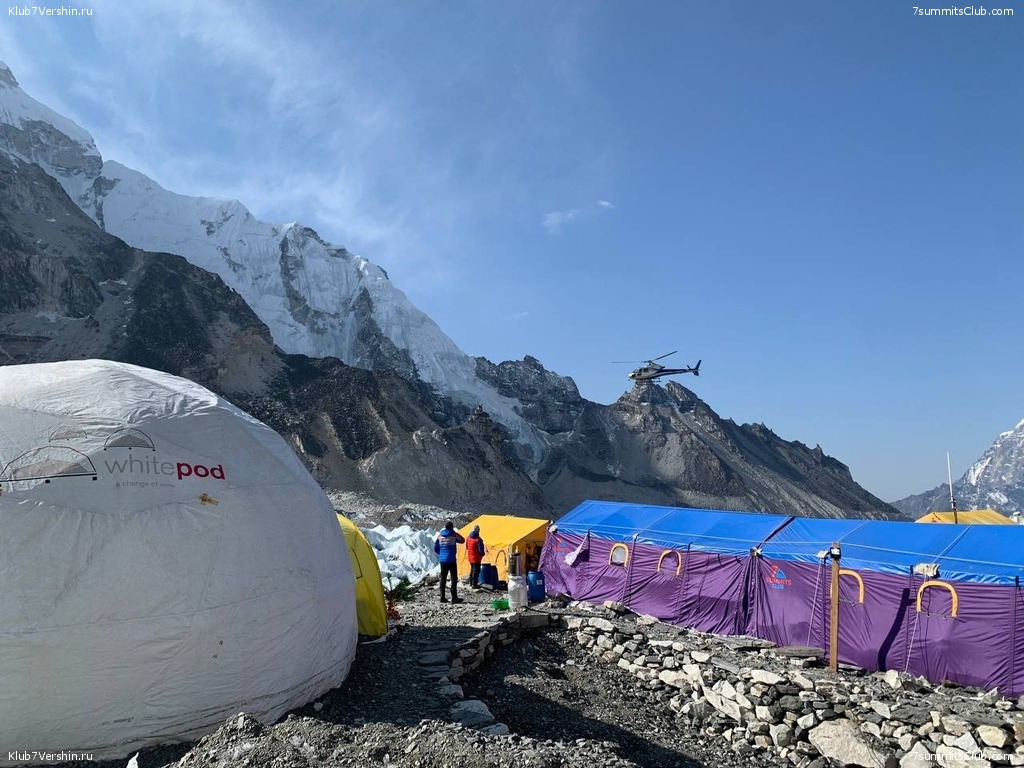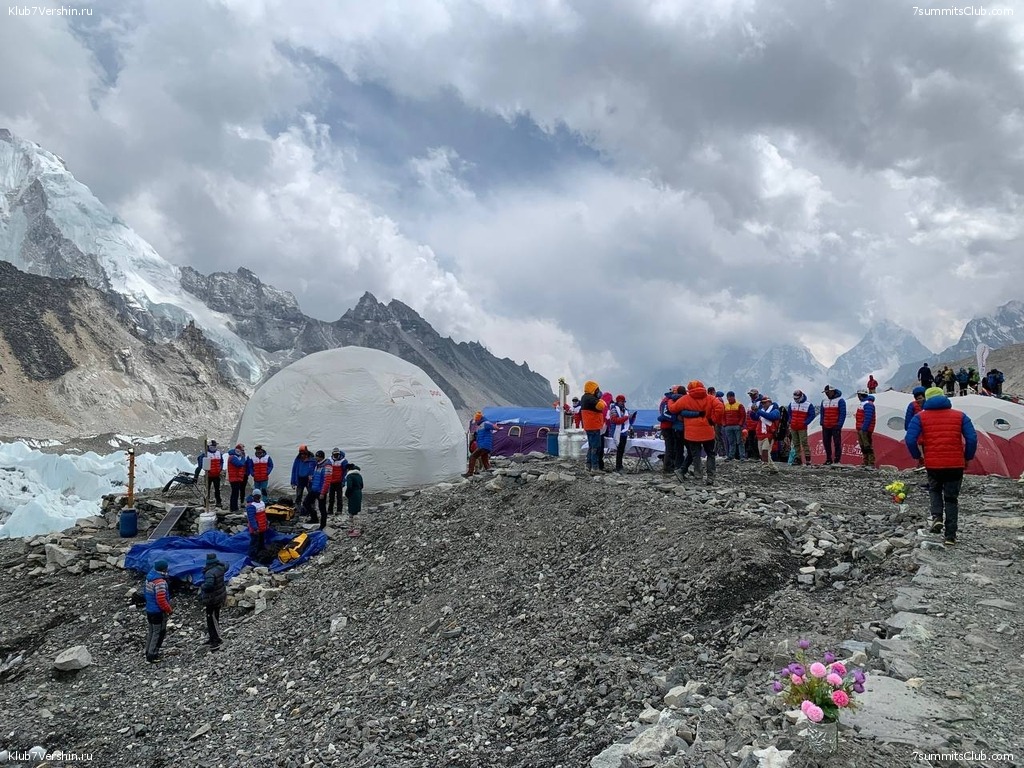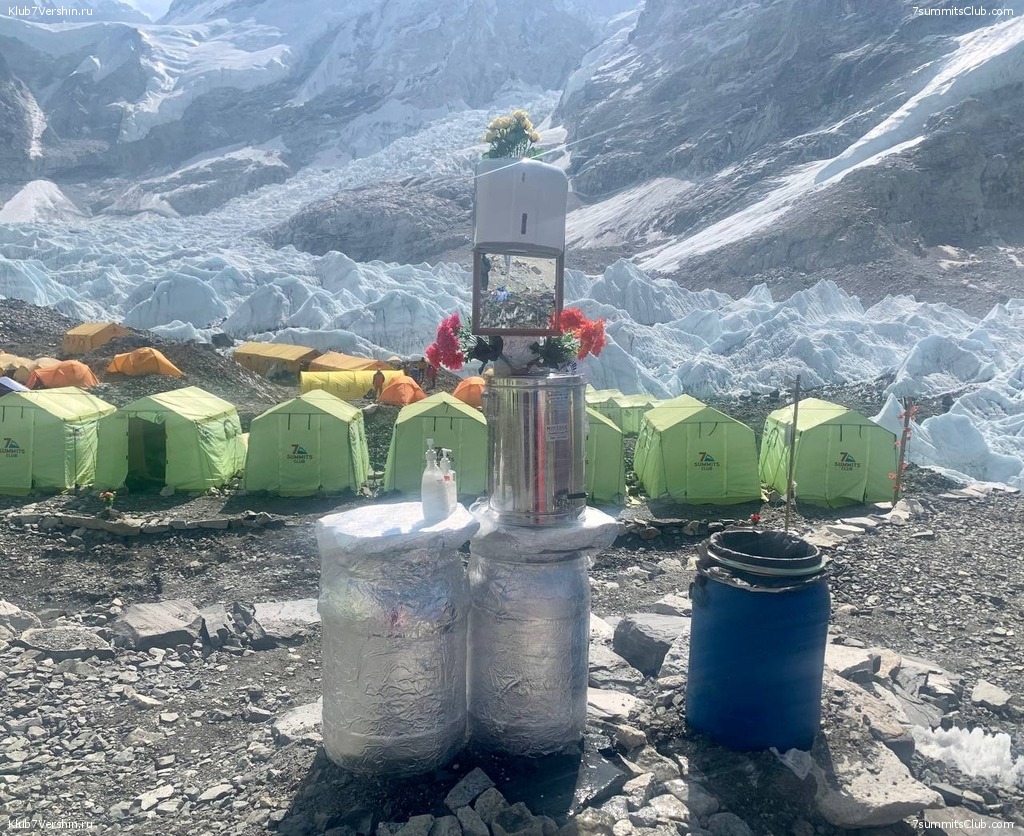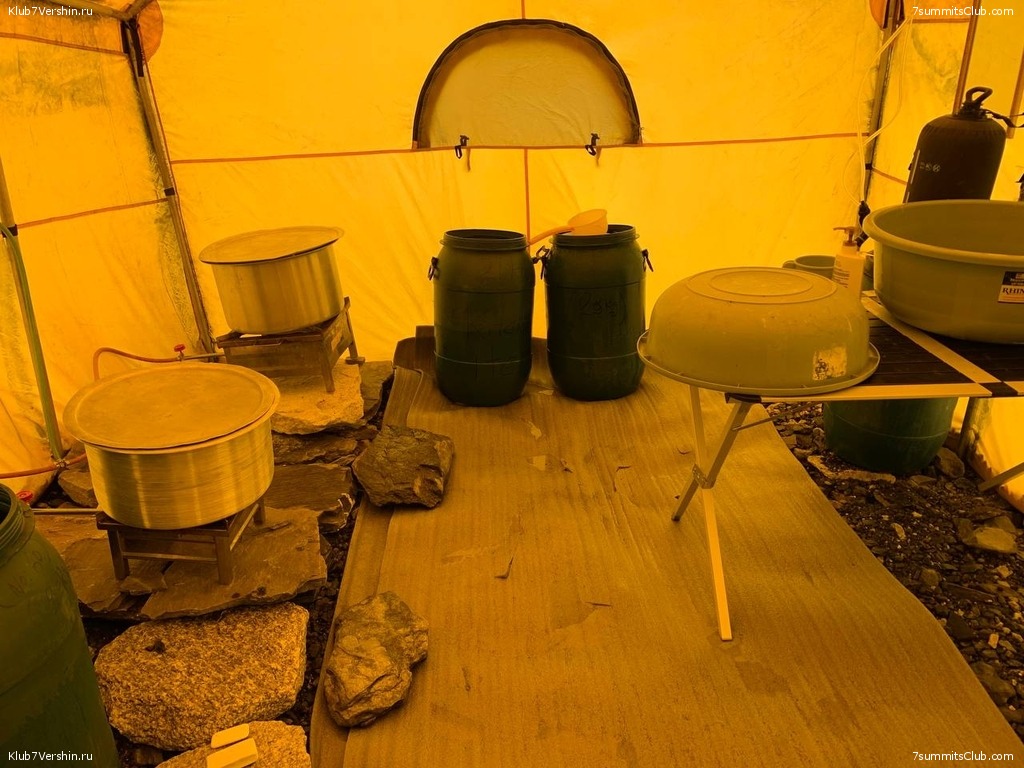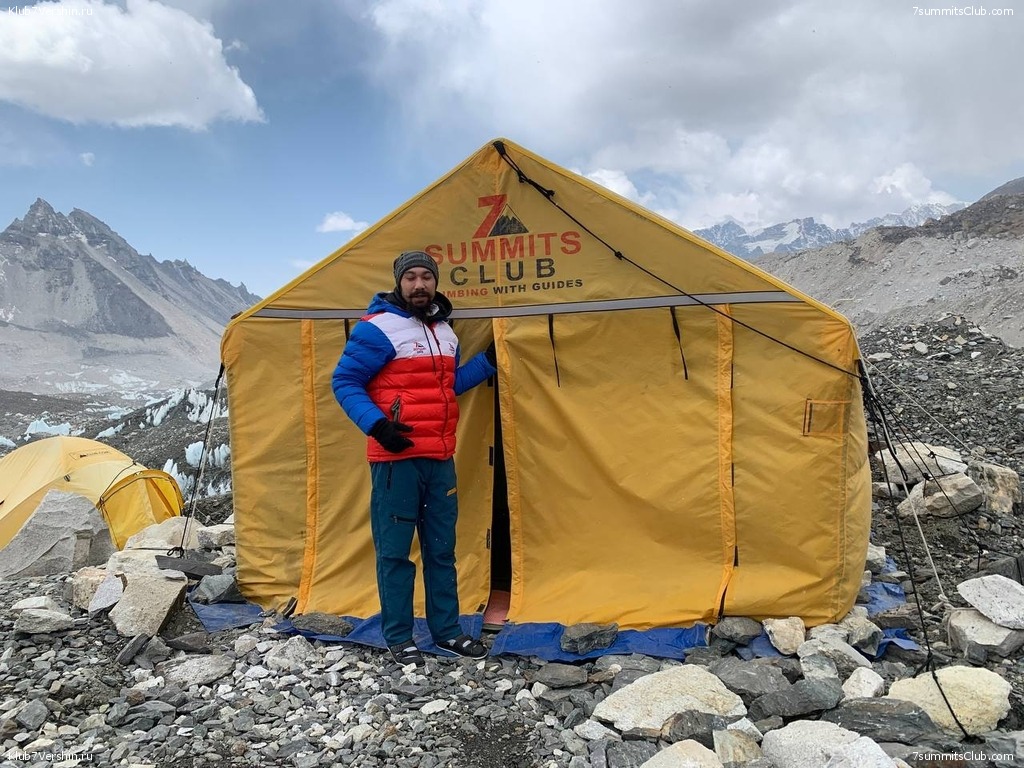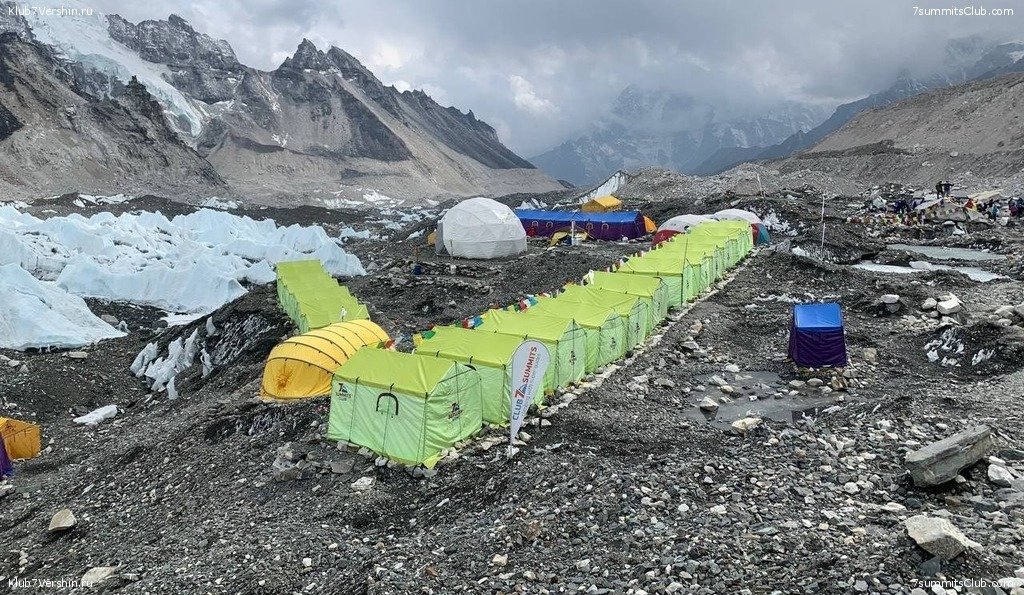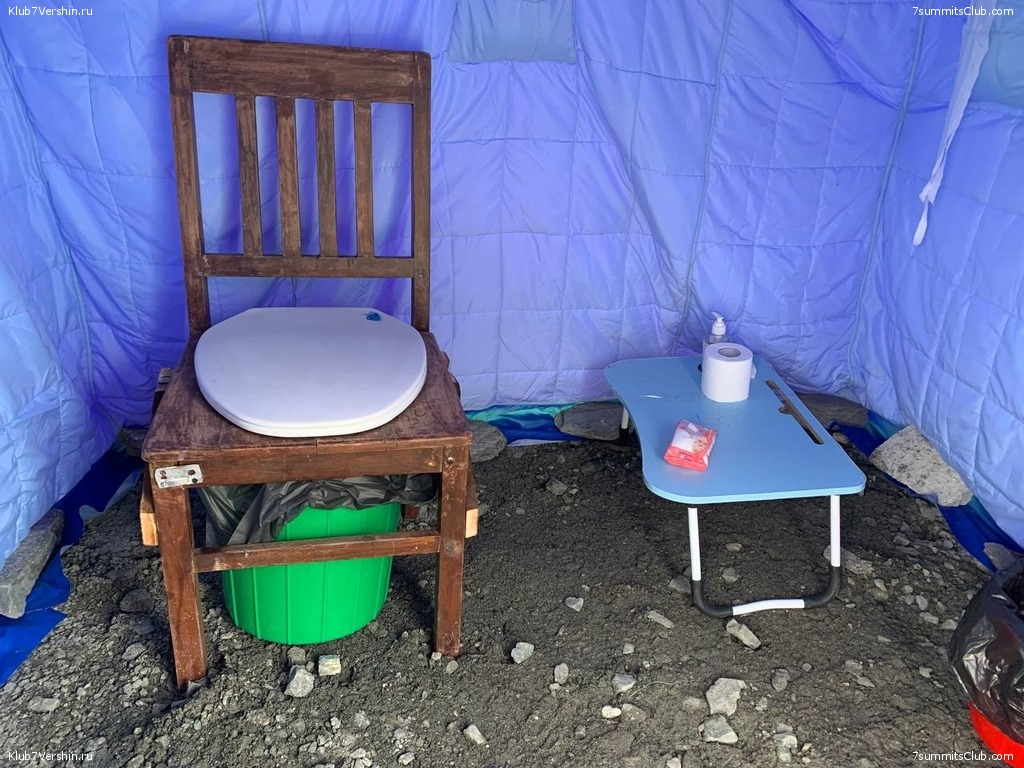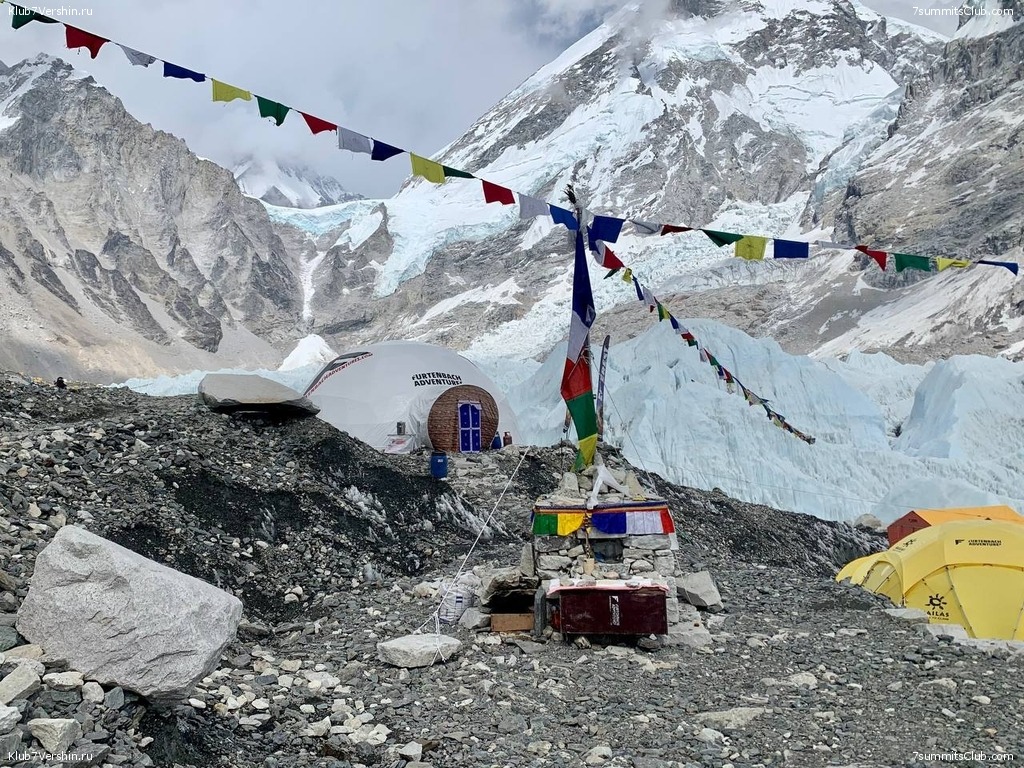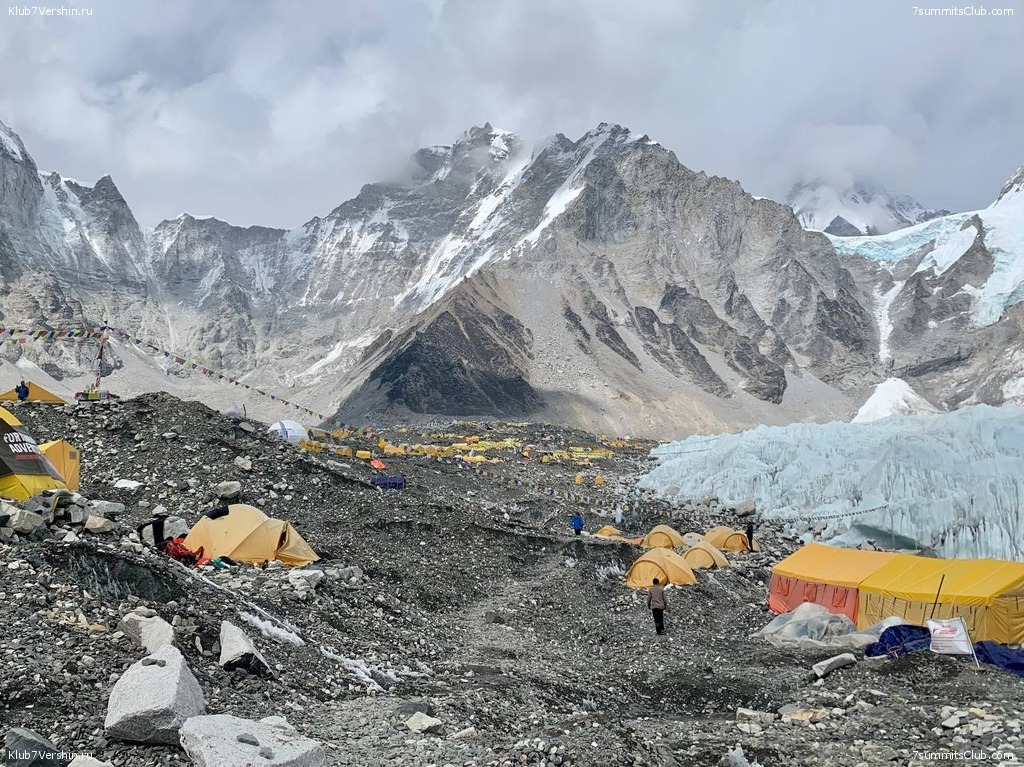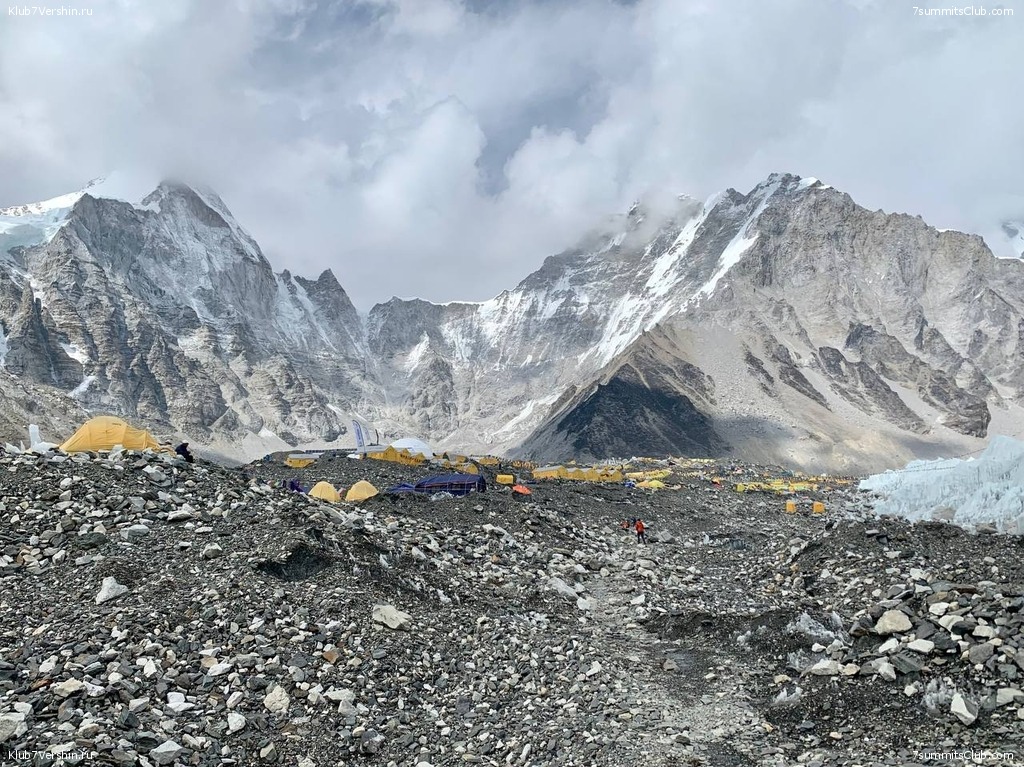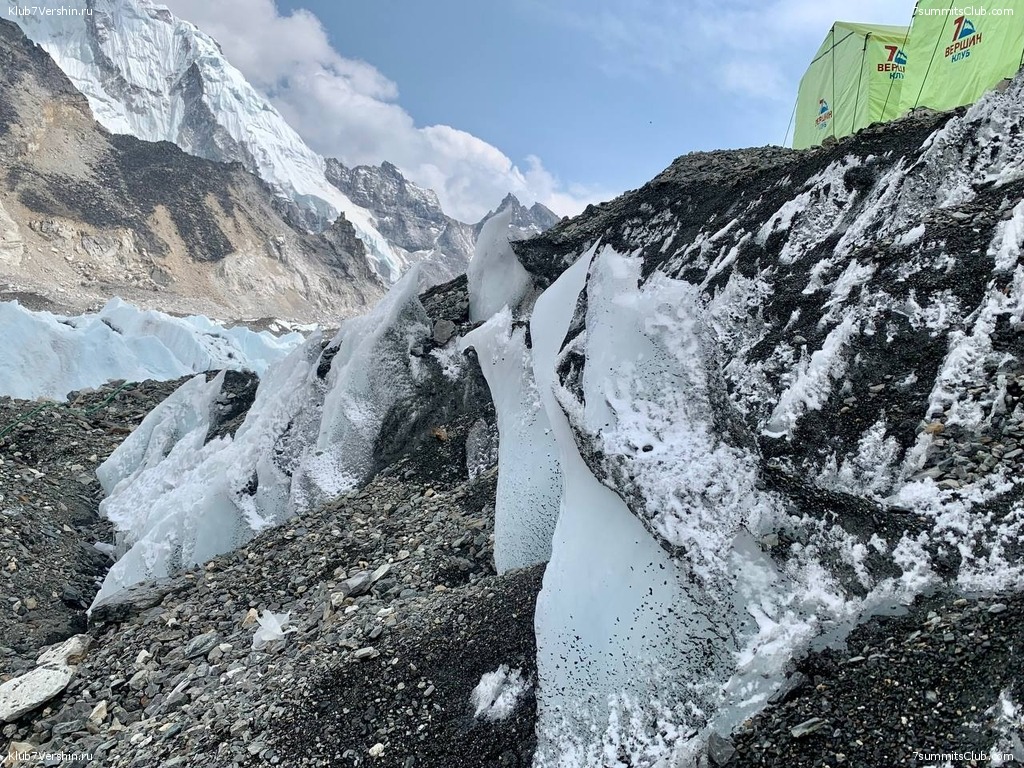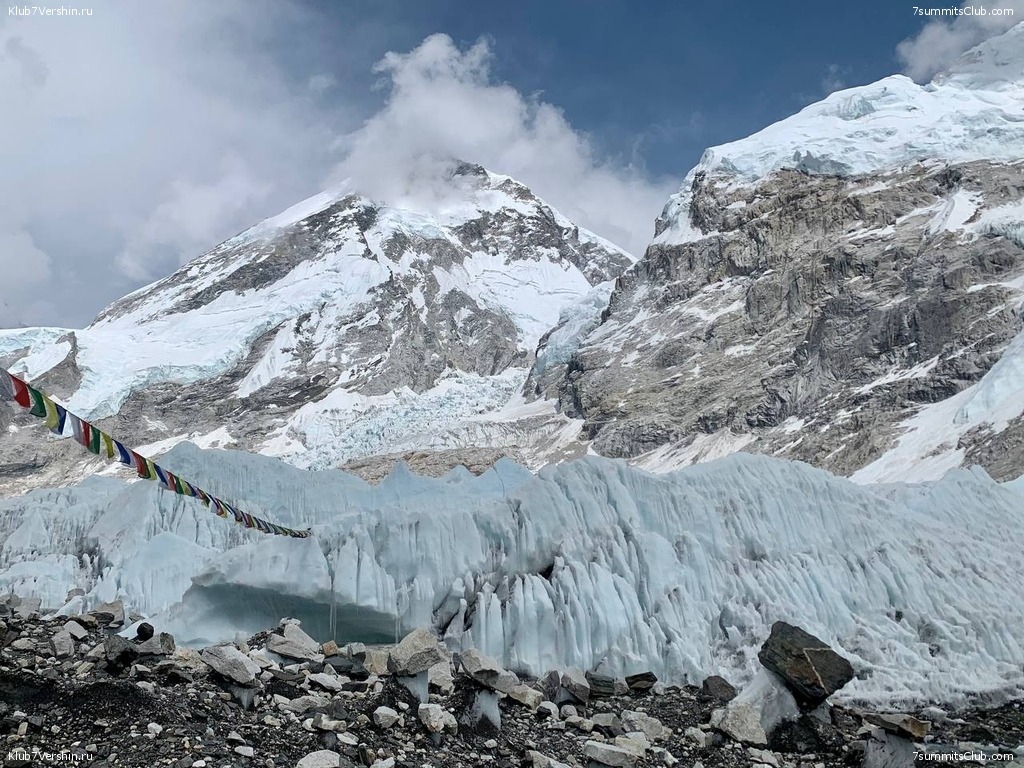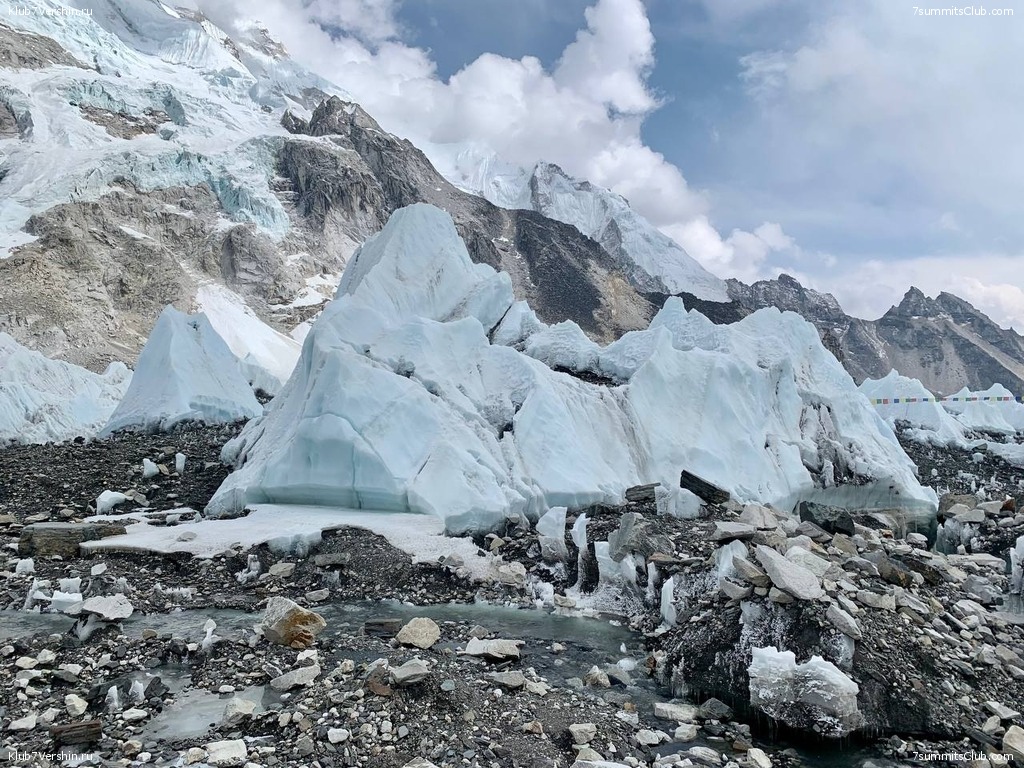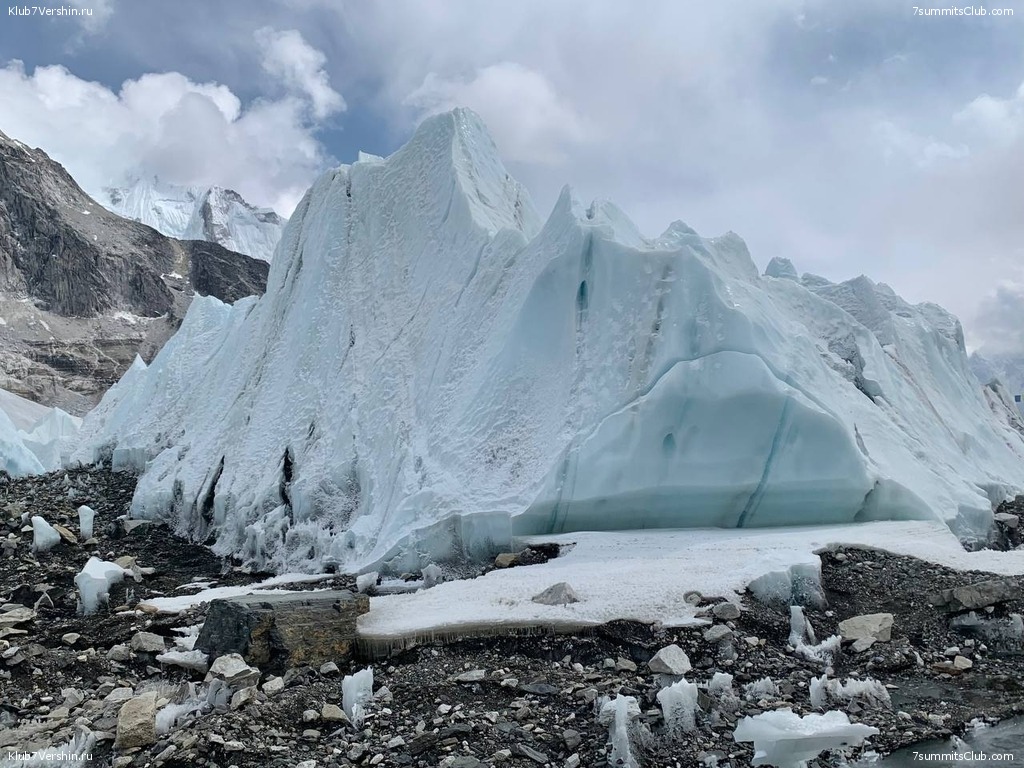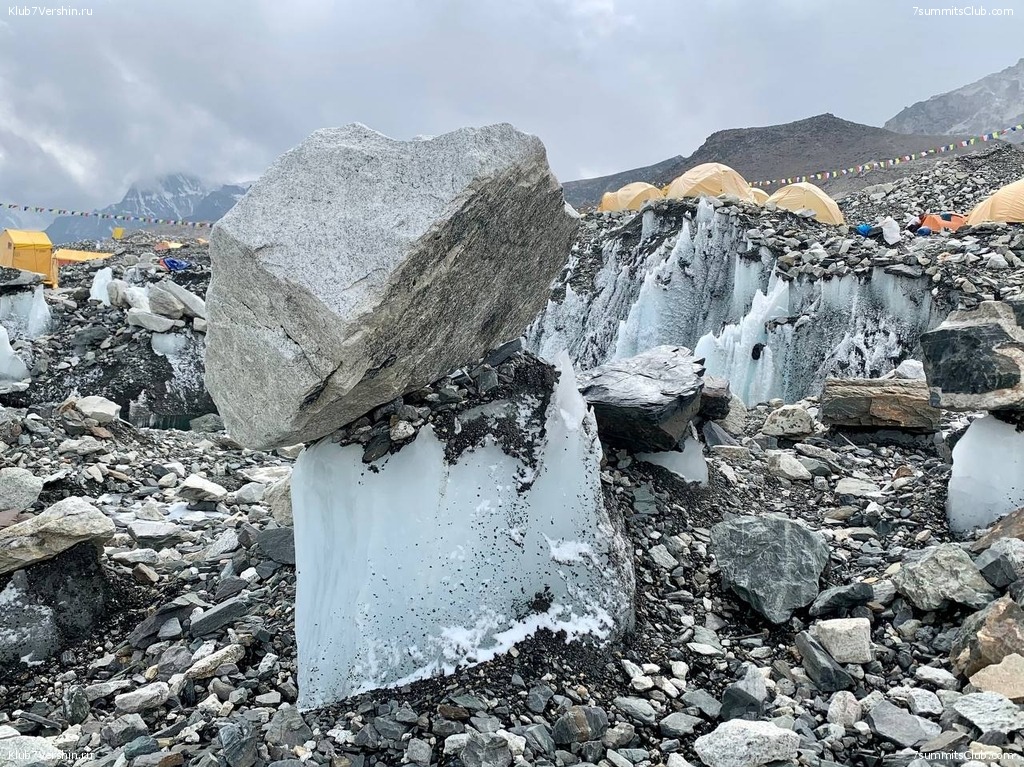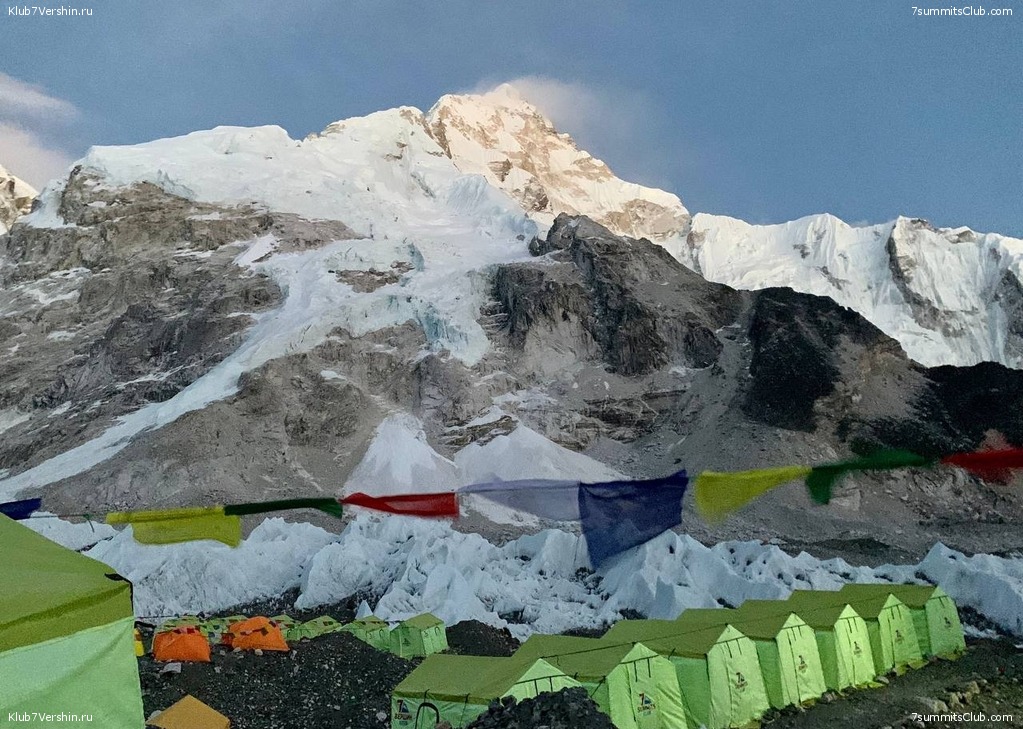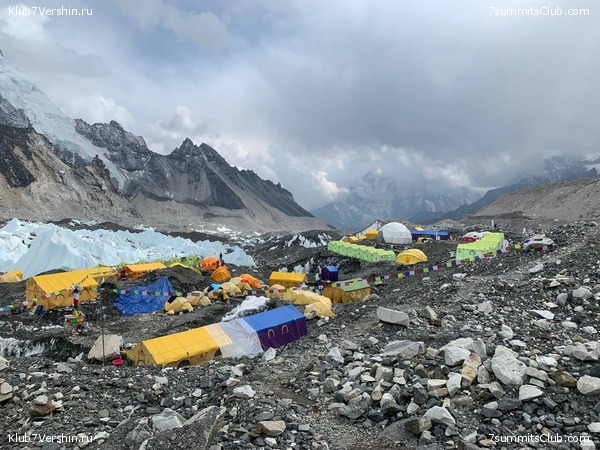Descriptions of travel routes
A large photo gallery from Olga Rumyantseva. Chronicle of the ascent of Wilhelm Peak in Papua New Guinea
Wilhelm.
On May 8, 2024, a group of the 7 Summits Club with guides Boris Egorov and Olga Rumyantseva climbed Wilhelm Peak, the highest peak in the country of Papua New Guinea.
Two days before, after a short move, we found ourselves in a paradise ...
On May 8, 2024, a group of the 7 Summits Club with guides Boris Egorov and Olga Rumyantseva climbed Wilhelm Peak, the highest peak in the country of Papua New Guinea.
Two days before, after a short move, we found ourselves in a paradise called Betty's Lodge, where we spent half a day among flowers, visited a trout farm and tasted fresh fish. The next day we moved to the base camp, making a trek through the picturesque jungle. This beautiful region pleased us not only with the already familiar views of jungles and swamps, but also with the most beautiful powerful waterfalls and mountain lakes, in which the most cheerful adventurers swam both before and after the ascent.
The ascent itself turned out to be quite a physically expensive event with elements of rock climbing and acrobatics. It was very difficult, but we all coped. Such an adventure will be remembered by everyone for a long time.
In the evening we returned to our beautiful lodge.
Notes by Olga Rumyantseva. Description of the 7 Summits Club Expedition Base Camp
Everest.
Let me, after all, fulfill my promise and start talking about how our camp is organized.
Here it is. Or rather, ours – it is in the right part of the frame, outlined by yellow tents.
That is, light green. The participants of the ...
Let me, after all, fulfill my promise and start talking about how our camp is organized.
Here it is. Or rather, ours – it is in the right part of the frame, outlined by yellow tents.
That is, light green. The participants of the expedition live in them - a slender row of 12 tents, guides and superiors - a row of smaller tents.
Of course, everyone is interested to know how it is inside. It's nice inside. These are two-layer insulated tents. Each tent is for one person. A small dressing room with hooks for clothes and hanging shelves.
And the main, insulated room, where there is a folding bed, mattress, blanket, pillow, small table.
The pillow, however, is so high that it is impossible to sleep on it.
Electricity is installed in the tent.
From a solar battery - very weak, but enough to keep the light on and it was possible to charge, for example, a powerbank through the USB connector.
There is also an extension 220. It is powered by a generator that is turned on from 17 to 22.
But it hasn't been working in my room for the second day. They promise to fix it. But not yet.
Hurray! The electricity was fixed for me.
But you can also charge electrical appliances in the dining salon, where there are several tables, an inflatable sofa, there are a bunch of extension cords and besides, it is heating.
There are also various board games and one paper book "Anna Karenina".
The dining salon is connected to the bar. In the bar, as usual, they pour. There is also a hair dryer, as it turned out today. Which is very valuable.
In the general photos, these are two hemispheres standing side by side.
Moving on. The long purple is the kitchen. Here the chef from La Sherpa restaurant makes wonders.
I'll tell you more about them later.
On the contrary, there are utility rooms in an orange large tent. And in the largest, white hemisphere there is a dining room. That is, a restaurant with a panoramic view of the glacier.
There are two washbasins next to the dining room. There is soap, antiseptic, paper towels.
In the mornings and evenings, warm water is poured there. So it's very comfortable to wash. But liquid soap is mostly frozen.
Well, since we are talking about washing, here is our washing room for you. It is located in a large orange tent. There is a dressing room where you can undress and a room where there are huge pots of hot water on the gas. There are also barrels of cold water.
The technology is simple: a basin, a ladle, mix water and wash. The main thing is, taking hot water, do not forget to add cold water to the pan so that it warms up for others.
There is also a portable shower where you need to pour water, but for me it's somehow easier with a basin.
The water is not constantly heated. They turn it on after breakfast and turn it off somewhere in two or three hours, when it gets cold and it won't work to wash without risking getting sick.
We have another big orange tent of the same size. It is a massage room. Well, inside the masseur lives by himself. While the sun is shining outside, as in all other tents, it is warm. As soon as the sun disappears, it becomes noticeably cool and it is better not to go for a massage.
And so the massage is wonderful.
Here, by the way, is our masseur. He has lived all his life in Kathmandu, he has never been to the mountains. This is his first high-altitude experience.
To acclimatize, he went trekking with us from Lukla and said that the higher the mountains, the more they admire him.
There is also a tent where the doctor lives. His medical office is also there. Fortunately, I haven't been inside yet.
Well, everyone, as usual, is interested in what's going on with the toilet.
You probably noticed several purple houses of a characteristic shape. That's what they are.
And inside it looks like this. Considering where we are, it's just gorgeous.
That's all, actually.
Summit. Photography by Oleg Pimenov from the peak of Margaret
Our friend Oleg Pimenov made an ascent to the third highest peak in Africa, Margaret peak. This is Mountains of the Moon in Uganda. ...
Our friend Oleg Pimenov made an ascent to the third highest peak in Africa, Margaret peak. This is Mountains of the Moon in Uganda.
All photo gallery
http://www.7vershin.ru/photos/all/section
Photos from the climb to the peak of Batian from Andrey Yerokhin and Anna Rybakova
Andrey Yerokhin, a professional mountain guide from Kyrgyzstan and one of the best friends of the 7 Summits Club Anna Rybakova climbed one of the objects of the program of 7 summits Club, which we called "Seven super-mountains". The highest ...
Andrey Yerokhin, a professional mountain guide from Kyrgyzstan and one of the best friends of the 7 Summits Club Anna Rybakova climbed one of the objects of the program of 7 summits Club, which we called "Seven super-mountains". The highest peak of Mount Kenya is called Batian and it has no easy and safe ways. This is a technical climbing, it was not easy to our friends, what tells Andrey Yerokhin.
The report in Russian,
here see photos…
Album. Project Antarctica: Nothing Left to Prove.
South Pole.
Project Antarctica: Nothing Left to Prove. Hardcover.by Grishkov Igor (Author), Klimov Sasha (Editor) Photos: On the Amazon:
Project Antarctica: Nothing Left to Prove. Hardcover.
by Grishkov Igor (Author), Klimov Sasha (Editor)
Photos:
On the Amazon:
Orizaba: Some impressions of V. Simonovich with NICE pictures
Orizaba.
I was with Israel Breton, who of his 37 years he goes to Orizaba 18 years .. What can I say .. For most physically fit people the ascent under such leadership will not be difficult .. We did 4.5 hours to the top and with the first ...
I was with Israel Breton, who of his 37 years he goes to Orizaba 18 years .. What can I say .. For most physically fit people the ascent under such leadership will not be difficult .. We did 4.5 hours to the top and with the first rays of the sun, I took out the camera.
Do not miss this moment when you could see a huge shadow of the mountain on top of which you are pleased to stand .. For some reason I always do not wish to go from the top … first long climb, climb, and then finish ! Striking feeling .. such pacification and then .. Especially on Everest struck it and I remember - all fussed with some flags, photographed "in memory " , although most in this situation rarely generally get at least some good shots , and I just stood there and watched the sunrise over the Earth, trying to understand where I remember what I saw .. And it was so nice and peaceful ..
So it was the same on Orizaba– quite met the sun, made some jump for pictures and we had to go down ..
FULL GALLERY >>>>>>>>
Climb Cho Oyu with the 7 Summits Club
From September 10 to October 20, an expedition of 7 Summits Club will be climbing the Mount of Cho Oyu. Minimum number of participants has been collected, the expedition will be guaranteed. But you can still join us. Welcome! Program of the ...
From September 10 to October 20, an expedition of 7 Summits Club will be climbing the Mount of Cho Oyu. Minimum number of participants has been collected, the expedition will be guaranteed. But you can still join us. Welcome!
Program of the expedition
Cho Oyu (8201 m) is the sixth highest mountain in the world, located a short distance to the west from Everest in the Khumbu region of Eastern Nepal along the Tibetan border.
There's no really technical sections and the objective dangers are close to non-existent. Its relatively easy access makes it an attractive climb for someone with limited time, as it can be attempted in roughly 6 weeks round trip. Base Camp is accessible by jeep and it is possible to reachKathmanduin a very long day from Base Camp.
Because of it's ease of access, ABC is often crowded with a large number of expeditions. Just west of Cho Oyu is the Nangpa La, the old trade route between the Khumbu Sherpas and Tibet.
It was the third such peak climbed, and the first climbed by light expedition and in Autumn. The mountain was first climbed on October 19, 1954 via the north-west ridge by Herbert Tichy, Joseph Jöchler and Sherpa Pasang Dawa Lama of an Austrian expedition. Cho Oyu was the fifth 8000 meters peak to be climbed, after Annapurna in June 1950, Mount Everest, Nanga Parbat and K2.
Project Alpari On Top of the World: planned routes and records
Elbrus.
February, 9 Ludmila Korobeshko flew to Argentina. The next day she was followed by Ivan Dusharin and Maxim Shakirov. So practical implementation of the program "Alpari on top of the world" begins. The 7 Summits Club not only ...
February, 9 Ludmila Korobeshko flew to Argentina. The next day she was followed by Ivan Dusharin and Maxim Shakirov. So practical implementation of the program "Alpari on top of the world" begins. The 7 Summits Club not only delegated to the program our director, but we take all organization and logistics. Alpari project can enter their place in the general history of the program Seven Summits. Here is a list of World and National records that our team can beat on success of the event:
1. Fastest collective (more than two people).
2. First all Seven by not classic routes.
3. First all Seven Summits by traverses.
4. The fastest female for the Seven Summits. At the moment the record is 360 days (Annabelle Bond, United Kingdom - Hong Kong)
5. The first TWICE of the 7 Summits for woman by Ludmila Korobeshko
All of them, of course records will be valid for Russia (Europe and CIS ....)
Actually it will be an absolute national record of speed for 7 summits.
And national age record for Ivan Dusharin - 65 years.
In Mendoza
Project Alpari: On Top of the World
Alpari has decided to take on a new challenge for the year 2012: planting the Alpari flag atop the tallest mountain on each continent. To accomplish this feat, we have put together a team consisting of three of the experienced mountain climbers from Russia has to offer. With this project, we are not only looking to expand our presence across the globe, to each of the world’s seven continents, but also to draw some attention to mountain climbing, a sport which has become something of a passion for many within our ranks.
“Mountain climbing as a spiritual journey… record-breaking climbs as a metaphor for achieving greater success in life,” commented Alpari Public Relations Director Dmitriy Tarasov. “This is something we can relate to. Alpari is a bona fide leader in the Forex industry. For us, there is no mountain too high.”
Mountain climbing is already somewhat of a tradition here at Alpari. As recently as 2010, a team of our employees took part in an expedition to Africa, planting the Alpari flag on the summit of Kilimanjaro. Not long before that, there was a trip to Mont Blanc. “Climbing mountains is a great tradition for us; one where we must overcome great difficulties, the cold and harsh living conditions. But we always manage,” said Alpari’s Chairman of the Board, Andrey Dashin.
No one in Russia has ever completed the world-famous “7 Summits” challenge in under a year. Alpari’s hand-picked team is looking to do just that!
We wish them good luck. And good weather !
Here’s the plan:
Aconcagua (South America): February 11-28 (18 days)
Kilimanjaro (Africa): March 7-13 (7 days)
Everest (Asia): April 11 – June 8 (59 days)
McKinley (North America): June 20 – July 10 (21 days)
Elbrus (Europe): September 1-7 (7 days)
Kosciuszko (Australia): November 3-7 (5 days)
Mount Vinson (Antarctica): December 1-19 (19 days)
ROUTES
Mount Aconcagua (6,962 m) – Although ascending Aconcagua often seems simple at first, this mountain is susceptible to sudden changes in weather and violent storms.
False Polish Traverse, descent by classic to Plaza de Mulos
Mount Kilimanjaro (5,895 m) – Ernest Hemingway once sang the praises of Kilimanjaro, which promises to be the perhaps the warmest and least inhospitable climb for our team.
Umbwe route, descent by Marangu route
Mount Everest (8,848 m) – Each year, the world’s tallest mountain draws in hundreds of climbers looking to test their personal limits, and each year, many of these climbers end up paying the ultimate price.
New route traverse North Summit (Chagtse) – Main Peak.
Descent to the North Col and ABC camp
For Everest Traverse our team will be strengthened. Currently, Alexander Abramov (as a leader), Ludmila Korobeshko, Ivan Dusharin, Maxim Shakirov and Mingma Gelu plan to take part in the ascent. The route will start from the campsite Changtse on the left moraine of the Rongphu Shar Glacier (Changtse camp - 6000m). From there the group plan to climb to the North (North East) ridge and then to the summit of Changtse 7543 meters. Where exactly they will rise to the North East ridge of Changtsze it will be determined on the spot. There are several options. From the top of Changtsze descent leads by a steepslope via South Ridge on the North Col - 7000m. Then the group will use standard camps on the classic route at 7700 and 8300 meters. From there they will try to climb the main summit of Everest (8848 m). Way back to the North Col and down to the standard camp ABC at 6400 meters.
From Jan Kielkowski. Mount Everest Massif
Àêùü
Mount McKinley (6,194 m) – Known to native Alaskans as Denali (“the great one”), McKinley is the tallest mountain in the world measured base to peak. During the ascent, climbers must confront the bitter cold, an exhaustingly long climb and stringent legal restrictions, including a policy which requires all climbers to carry all of their “waste” back to base camp.
West Rib
Descent by Western Buttress route
Mount Elbrus (5,642 m) – Located in the Caucasus Mountains, Elbrus demands a great deal of focus and discipline from climbers. This guileful inactive volcano often surprises climbers with streaks of brutal winter weather and strong winds.
Traverse from the East (Irik Valley) Eastern Peak - Western Peak
Descent via the Khotiu-Tau Pass
Mount Kosciuszko (2,228 m) – Getting to this mountain is difficult, but the view from the top makes the trip worth it.
Route Main Ridge Track from Charlotte Pass
Descent to Thredbo
Mount Vinson (4,897 m) – Our climbers will come face-to-face with ice storms and some of the coldest weather on our planet to reach the highest peak in Antarctica.
Probably Rudi's Runway (Lang 1991) Route
The team
Ludmila Korobeshko
Ludmila was the first woman from Russia to complete the “Seven Summits” challenge and just the third Russian woman to climb Everest. Her resume includes more than 50 successful climbs and a trip to the North Pole. She has been working as a mountain guide/translator and organizing expeditions for more than a decade. She also writes and makes short films.
The first Russian woman to complete the “7 Summits” challenge
The first Russian woman to complete the “7 Summits +1” challenge (the +1 being the Puncak Jaya, or Carstensz Pyramid, in Indonesia)
The third Russian woman to climb Everes
An experienced mountain guide and director of the “7 Summits Club”
14 years of experience climbing mountains and organizing expeditions (9 years professionally)
More than 100 successful ascents across the world
Class A mountain climber, guide, English translator
Has climbed and trekked in the mountains of the Causasus (Russia), France, Peru, the United States, Tibet, Nepal, Mexico, Argentina, Ecuador, Tanzania, Ukraine, Australia, New Zealand, Japan and Turkey
Has led more than 20 expeditions to the peak of Elbrus
Ivan Dusharin
Ivan is a world-class mountain climber with more than 300 successful climbs under his belt, including Everest. He is an experienced guide and leads expeditions all around the world. His hobbies include photography and filmmaking. Dusharin is the author of a book “Crossing the Abyss on a Wire”.
http://www.alpari-life.ru/en/alpinisty_vaza/
Maxim Shakirov
Maxim is the man behind “New Year’s on the Summit” as well as a 2014 Olympic Games flag-bearer. He has already planted the Olympic flag atop mountains on five continents, including Mount Everest. He is a journalist, filmmaker, photographer and traveler
Khan-Tengri. We have come back. Impressions and memories.
We have just come back from Tian Shan. The trip has excited us and provoked strong feelings which are not easy to be described. Can you imagine the brightness of the greenery near Carcara river, the cold slopes of Khan-Tengri, walking ...
We have just come back from Tian Shan. The trip has excited us and provoked strong feelings which are not easy to be described. Can you imagine the brightness of the greenery near Carcara river, the cold slopes of Khan-Tengri, walking up to the Camp 2 on rimed fixed ropes, dodging from stones while rising to the Camp 3, 4-days exhausting waiting for good weather in the assault camp, the day of the ascent, descending to the South where the views were wonderful, the South Inilchek with its unique atmosphere, relax near the Issyk Kul lake…? During the way we have met the legends of alpinism like Kazbeck Hamitsaev, Nikolay Gilin, Aleksandr Koloskov, Dmitrij Grekov, Dmitrij Pavlienko, and we have also met our old friends and some new interesting people.
Two participants of our expedition, Sergej Shekoldin and Andrej Ulin, deserve to be respected especially. They have reached the summit in spite of big difficulties like bad weather conditions and loss of experience.
I’d like also to thank our guides, Ura Lyabin and Dima Ermakov.
In the middle of expedition we were left by Sasha Victorov. He had decided that he didn’t have enough experience for such difficult ascent. In my opinion, his decision was reasonable. However, he managed to reach the Camp 2, and anyway that's something.
As for me, I haven’t reached the summit this time. When we left the assault camp at 4 o’clock in the morning after long waiting, I understood that I really felt terrible and couldn’t walk fast enough. That was the mountain sickness probably. It was pity and difficult to walk down. I felt disappointment… I hope I’ll have another chance to climb this mountain.
Project 7 Volcanoes: Mount Sidley (Antarctica), the first climbing expedition
Sidley.
Program “Seven volcanoes”, it is climbing the highest volcanoes all continents over the world, Club Seven Summits organized in early 2011 the first mountaineering expedition to the highest volcano in Antarctica Mt. Sidley. Head ...
Program “Seven volcanoes”, it is climbing the highest volcanoes all continents over the world, Club Seven Summits organized in early 2011 the first mountaineering expedition to the highest volcano in Antarctica Mt. Sidley. Head of expedition - Alexander Abramov. Among confirmed participants: Dmitry Moskalev, Italian Mario Trimeri (who can become the first person climbed the seven volcanoes), Romanian climber Crina Popescu, which in December will celebrate 16 years (she also ends the program "Seven of the Volcanoes").
Mount Sidley is located in the mountain massive Executive Committee Range. This is chain of volcanic mountains in Antarctica, called the Marie Byrd Land. The thickness of the ice cover in this part of the continent achieves two kilometers. In the case of complete disappearance of the ice covered at this site will be an archipelago of volcanic islands such as Japan.
The height of the Mountain Sidley - 4,285 meters, the foot of the volcano has an altitude of about 2500 meters. Coordinates: 77 ° 02 'S 126 ° 06'z. E..
Mt. Sidley - a gigantic volcanic massif, a huge bulge dominates the uniform ice surface of the surrounding area. One side of the mountains form a huge caldera crater with a diameter of 5 km, its walls towering about one km altitude. And there may be found difficult climbing routes. On the other side there is only a gentle slope and the path to the summit can be maid on skis. However, the question with the highest point is still not fully clear. There may be several points in the ridge
We will have to check several points in the long summit ridge, with GPS, make sure a correct climbing line for next climbers. So we have to climb with the elements of a full exploration, as we have no high-quality report from first climbers.
American base in 2000 and Mt.Sidley
The mountain was discovered by Rear Admiral Richard E. Byrd on an airplane flight, November 18, 1934, and named by him for Mabelle E. Sidley, the daughter of William Horlick who was a contributor to the 1933–35 Byrd Antarctic Expedition. Despite its lofty status, the volcano languishes in obscurity due to its extremely remote location. It is little known even in the mountaineering world compared to the far more famous Mount Erebus, the second highest Antarctic volcano which is located near the U.S. and New Zealand bases on Ross Island. The first recorded ascent of Mount Sidley was by New Zealander Bill Atkinson on January 11, 1990, whilst working in support of a USAP scientific field party.
For the first time the foot of the volcano Seeley was reached by scholars of the American Antarctic Expedition ATV in the season 1958-59. The leader of expedition a Scottish glaciologist John Pirrin climbed up its slope nearly to the top, but to the highest point is not reached.
Under the program of studies US-ITASE American scientists visited the volcano area Seeley in 2000. Then they have a large collection of rocks and minerals, which enabled them to reconstruct the geological history of the volcano.
The route of our ascent involves a standard flight Punta Arenas - Patriot Hills on the big plane and then to the base camp on Mount Sidley on a small plane. What is the ascent to the summit, we can only guess. But we hope that our expedition will go down in history in many ways. And above all, accurately establishing the route, identifying the highest point of the ridge, taking pictures of all this and widespread throughout the world of information.
Russkaya station at Cape Berks on coast of Marie Byrd Land worked in ten years (1980-1990), it is only 300 km from Mt. Sidley.

